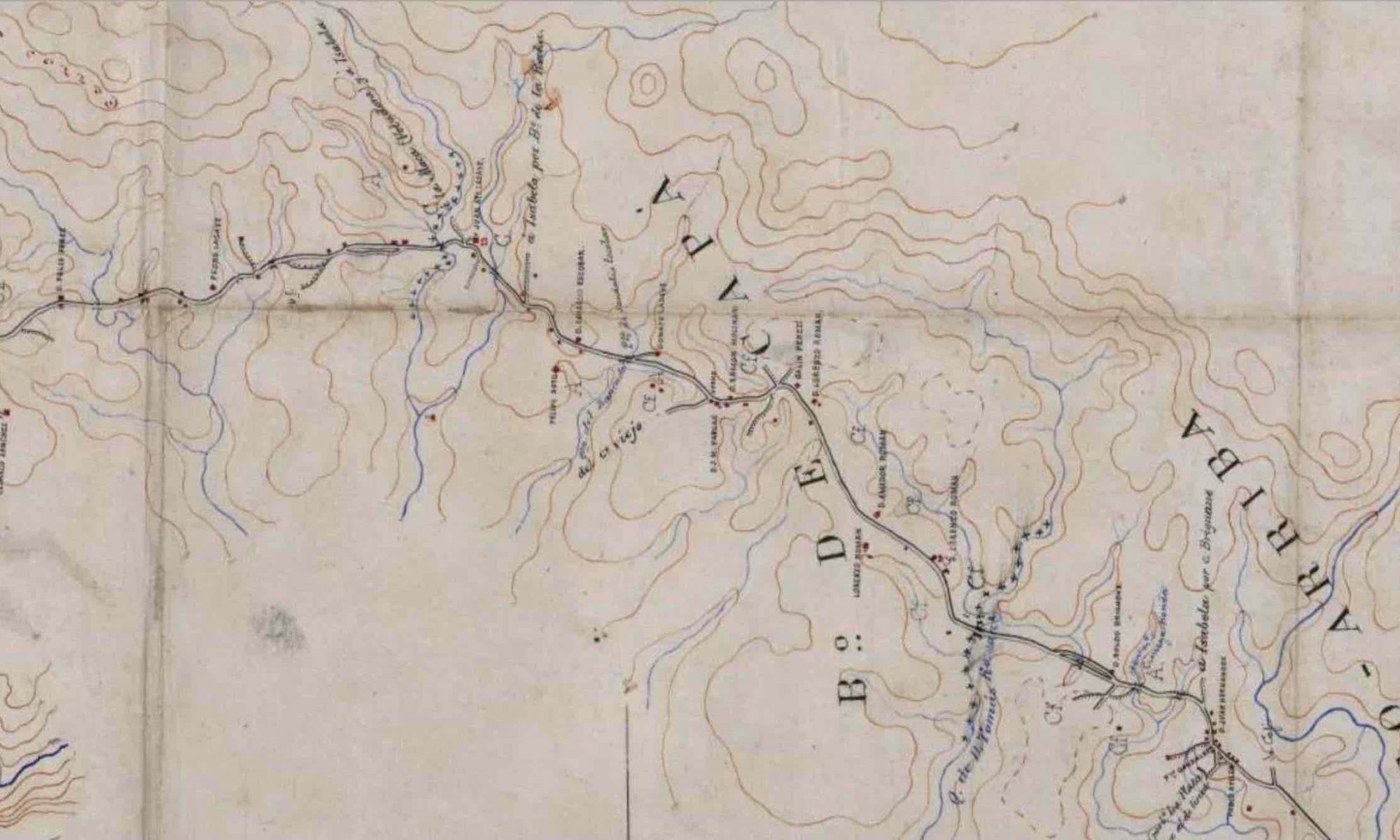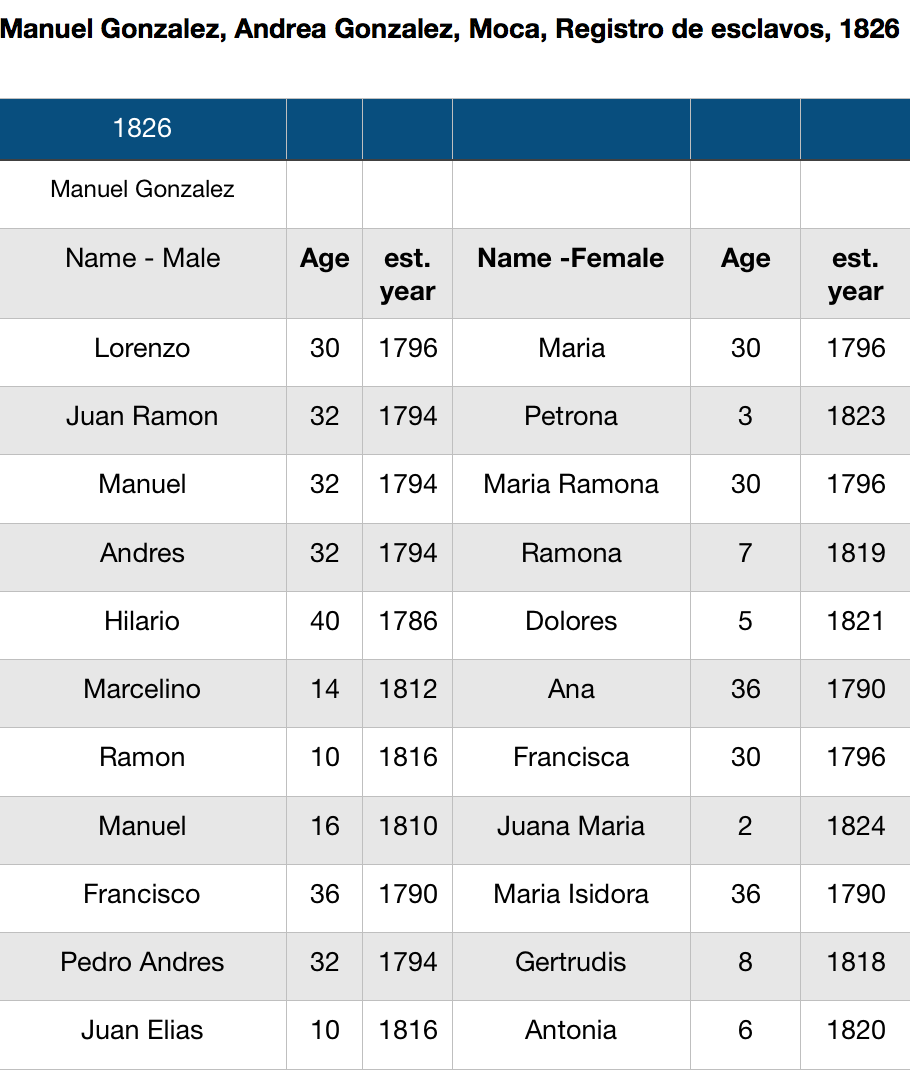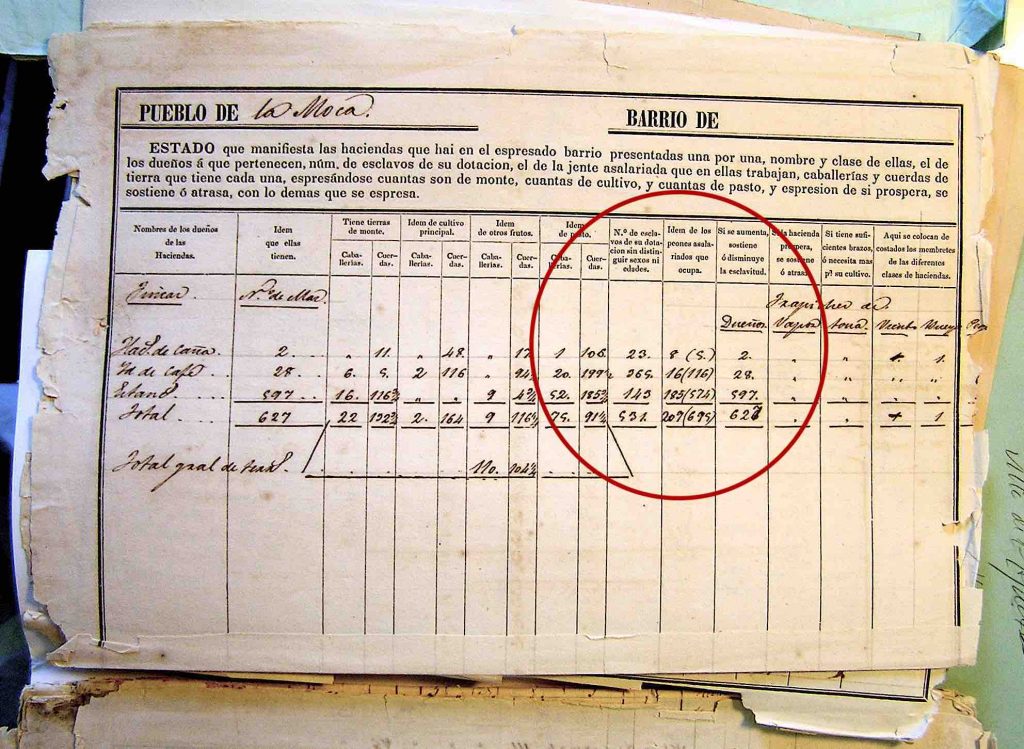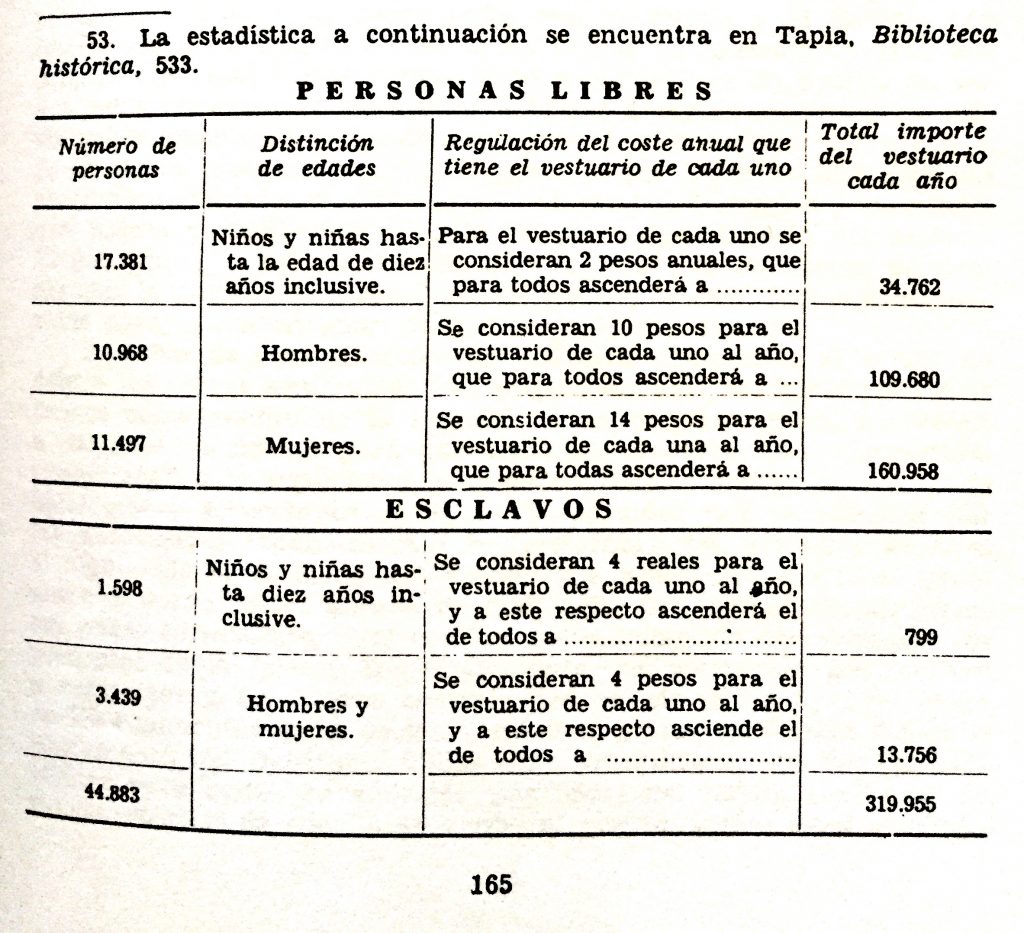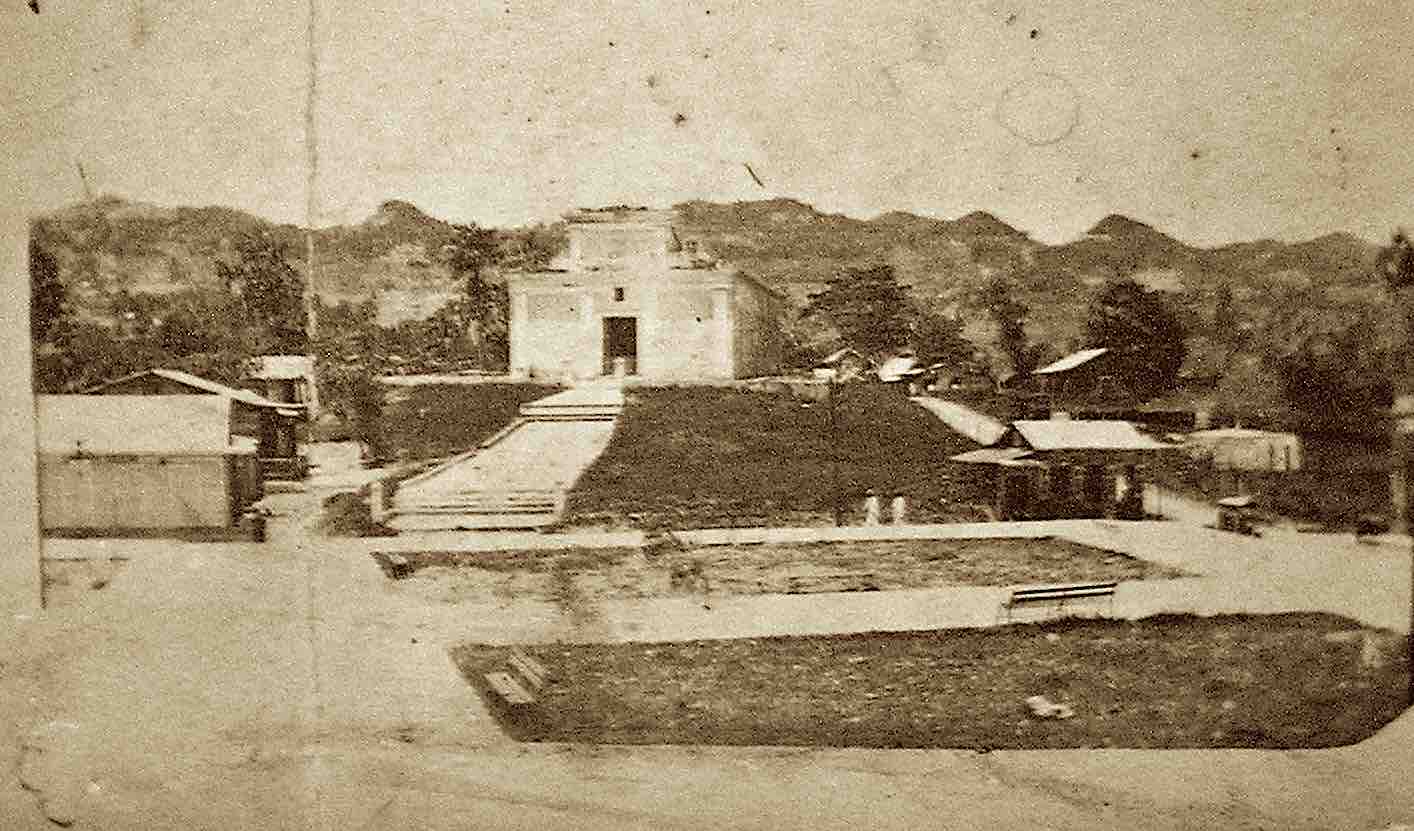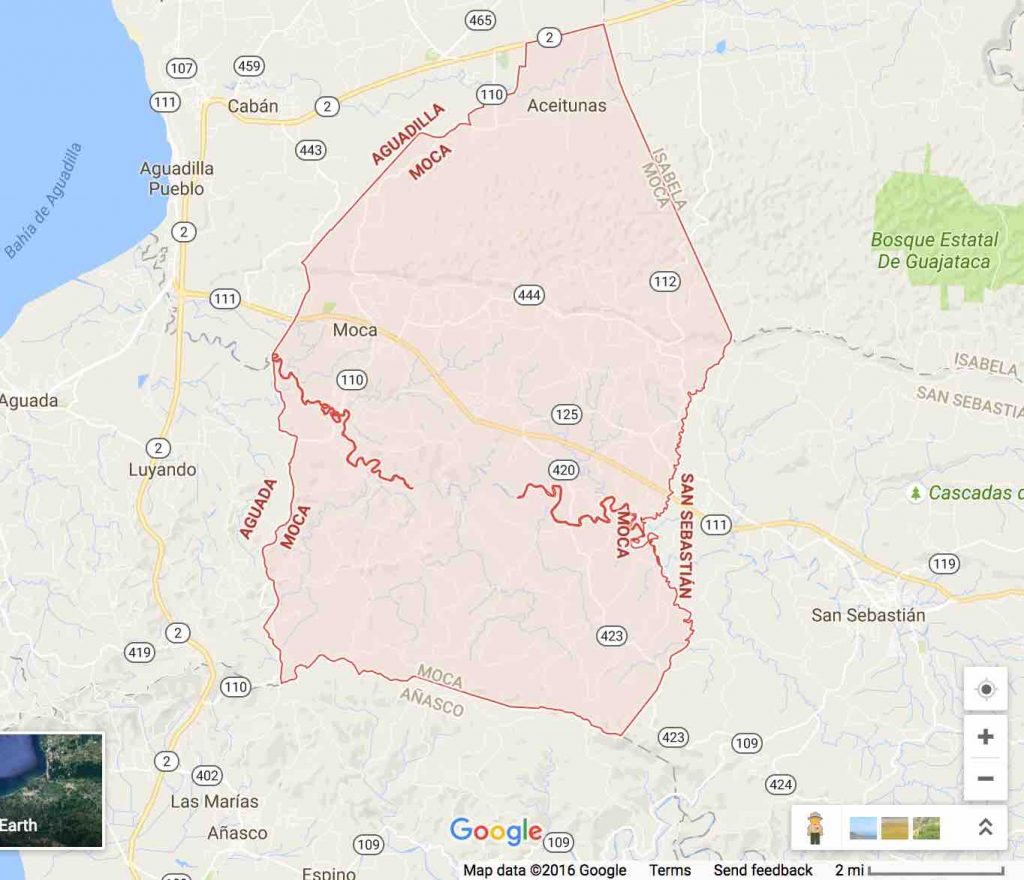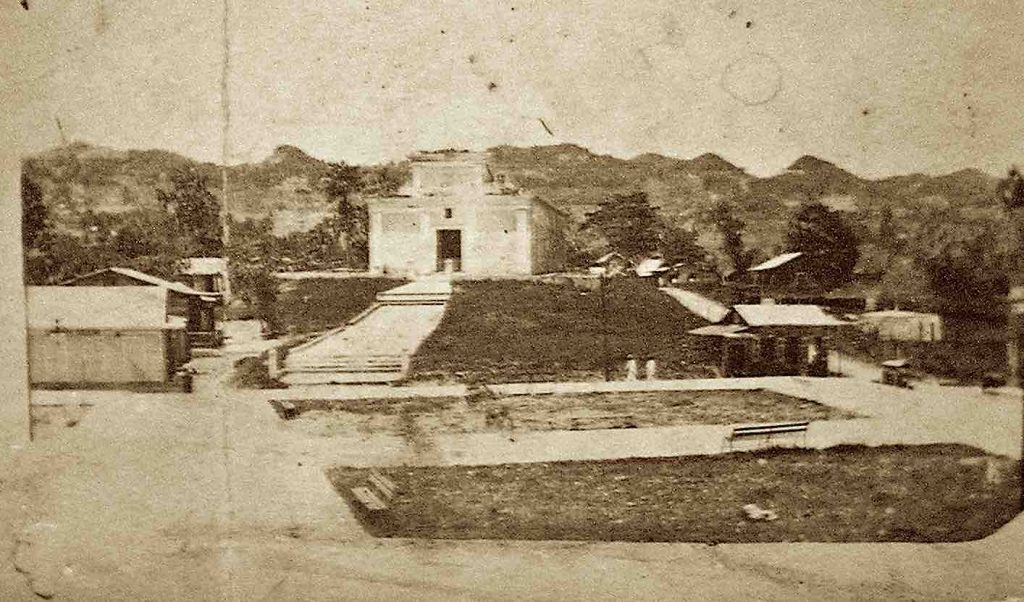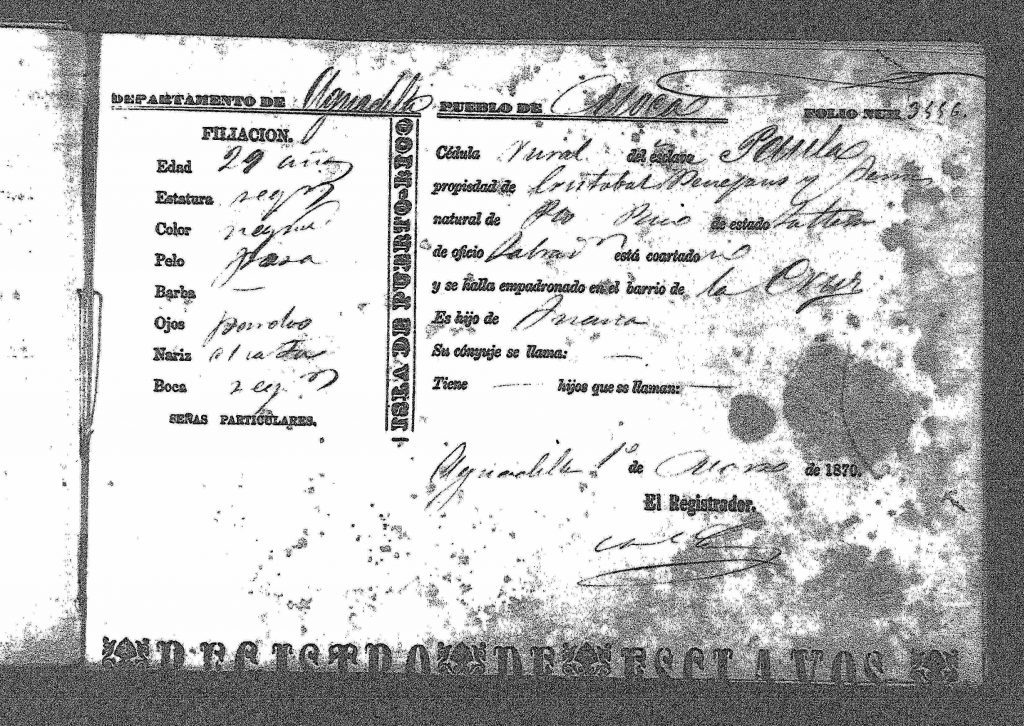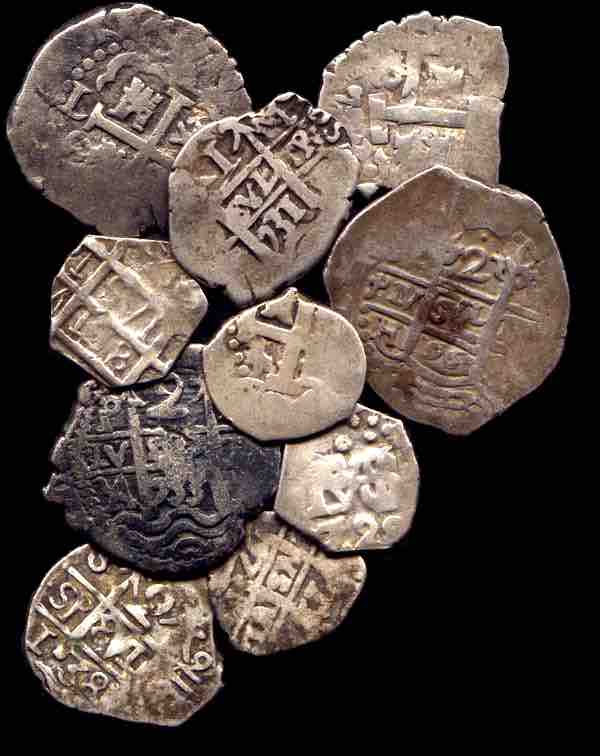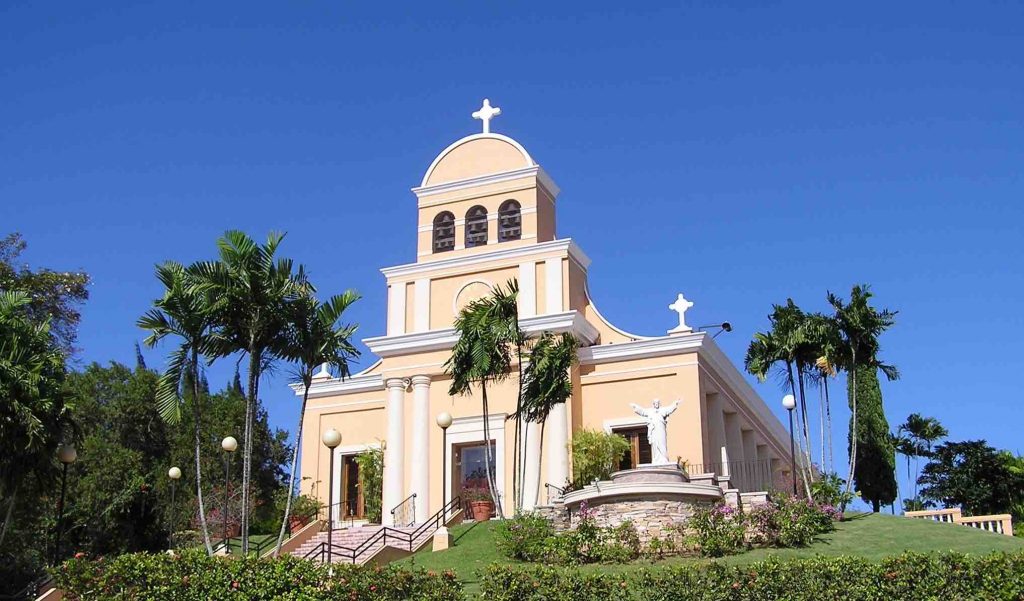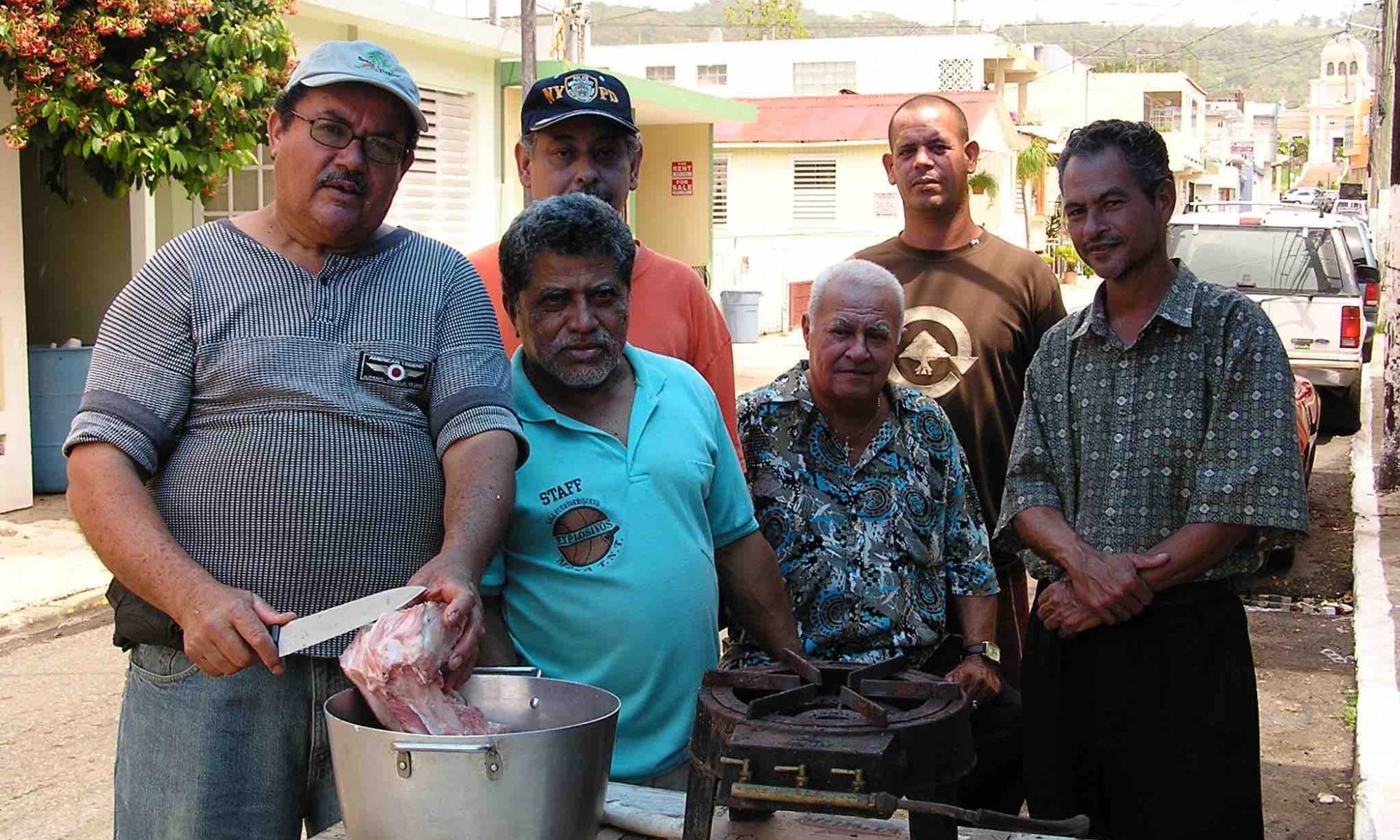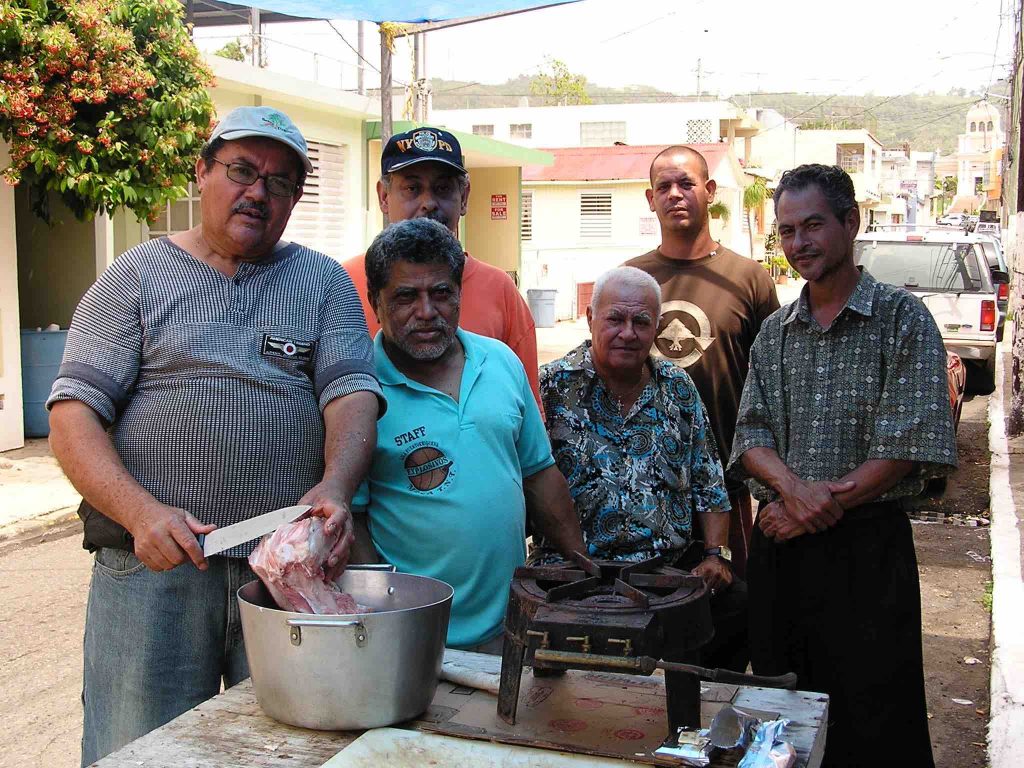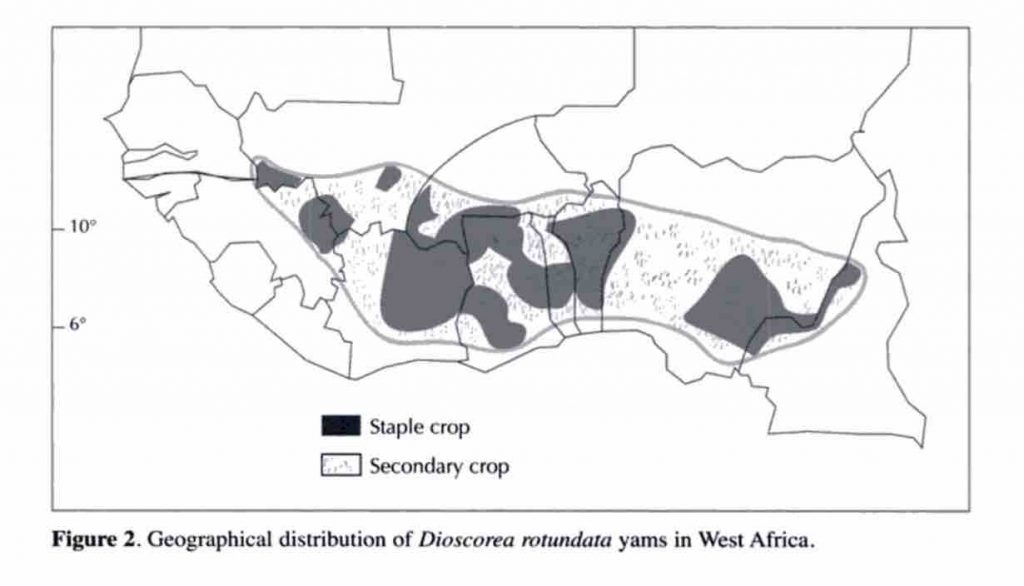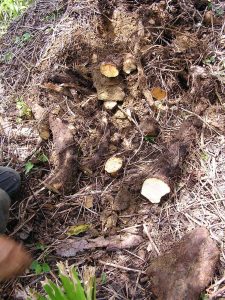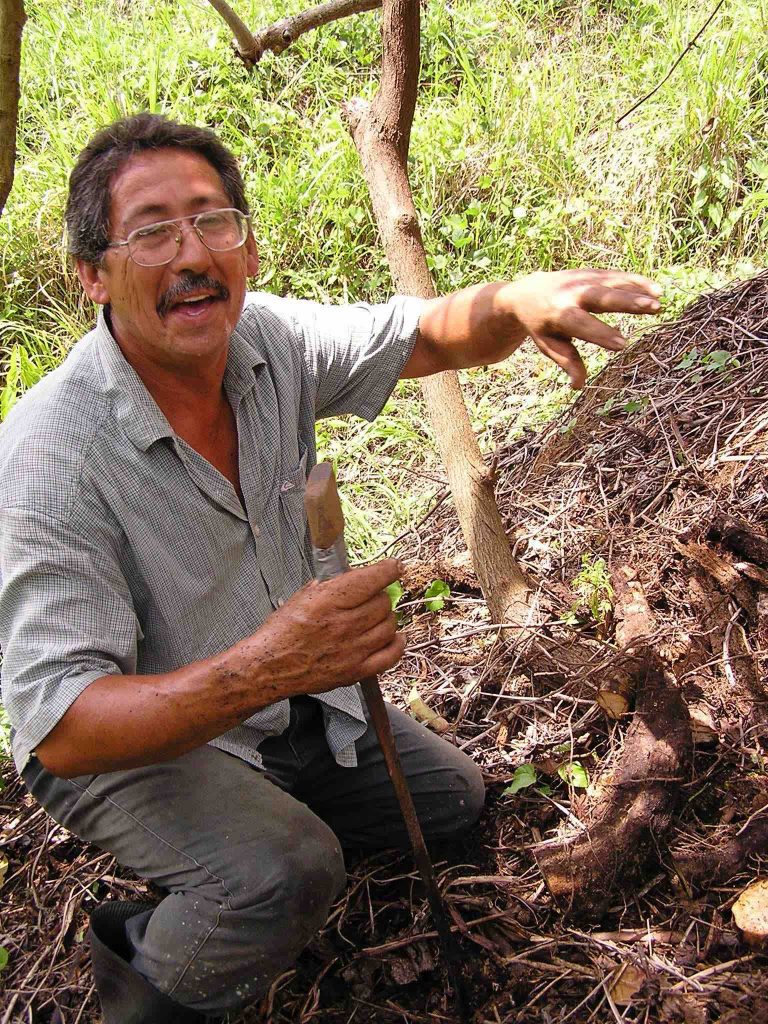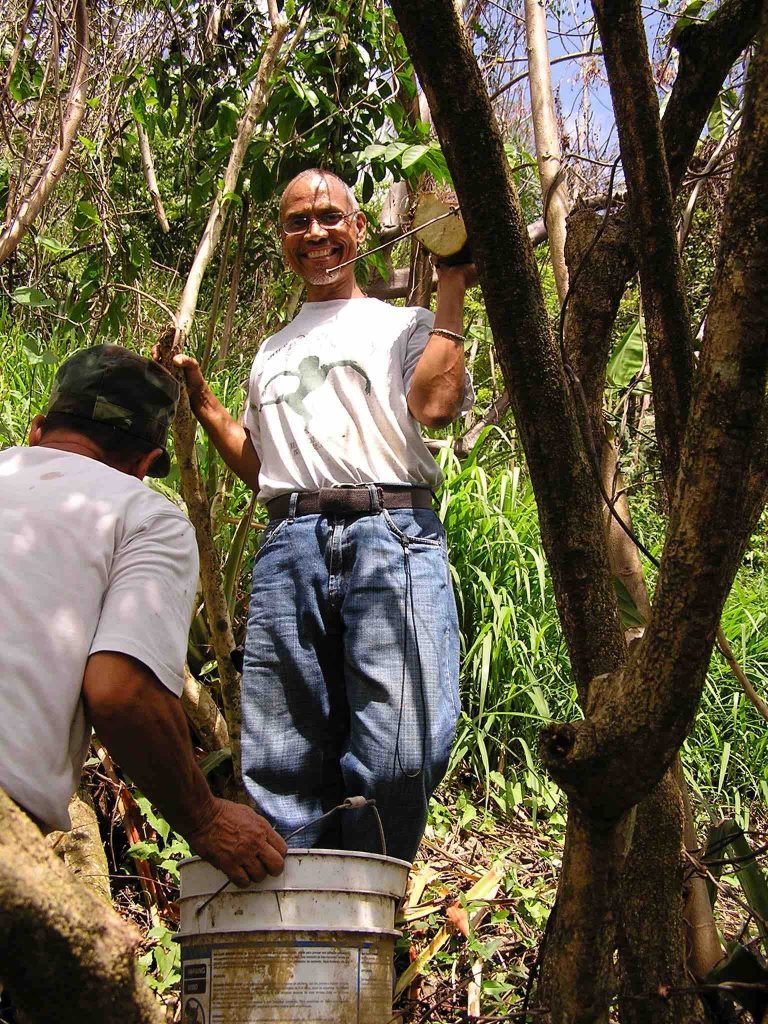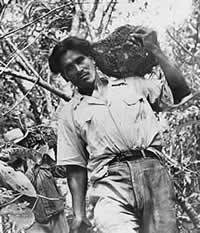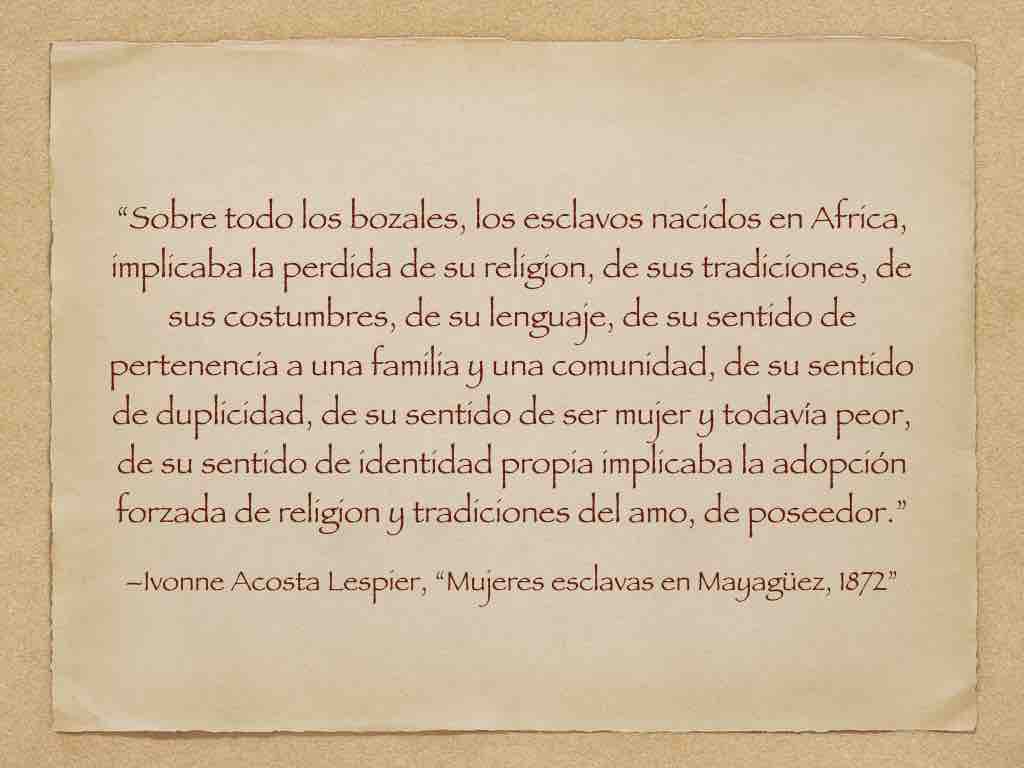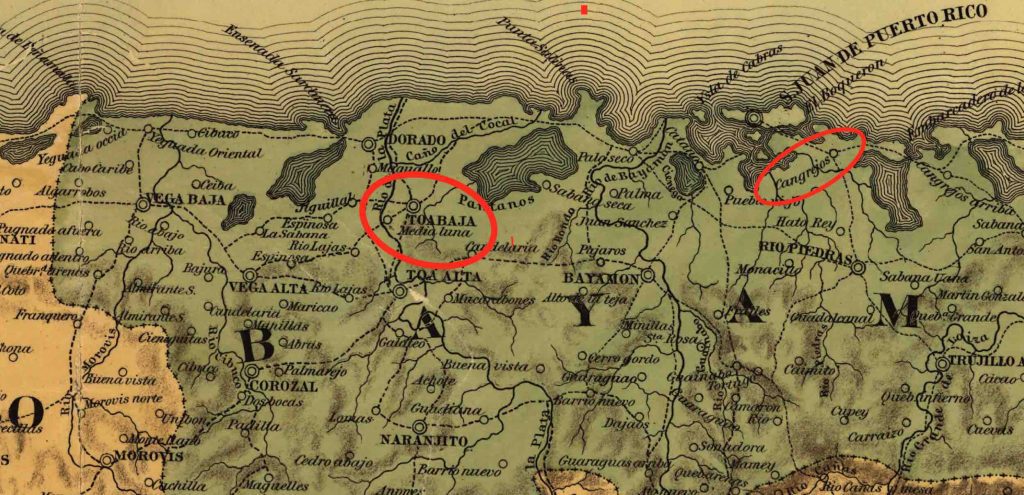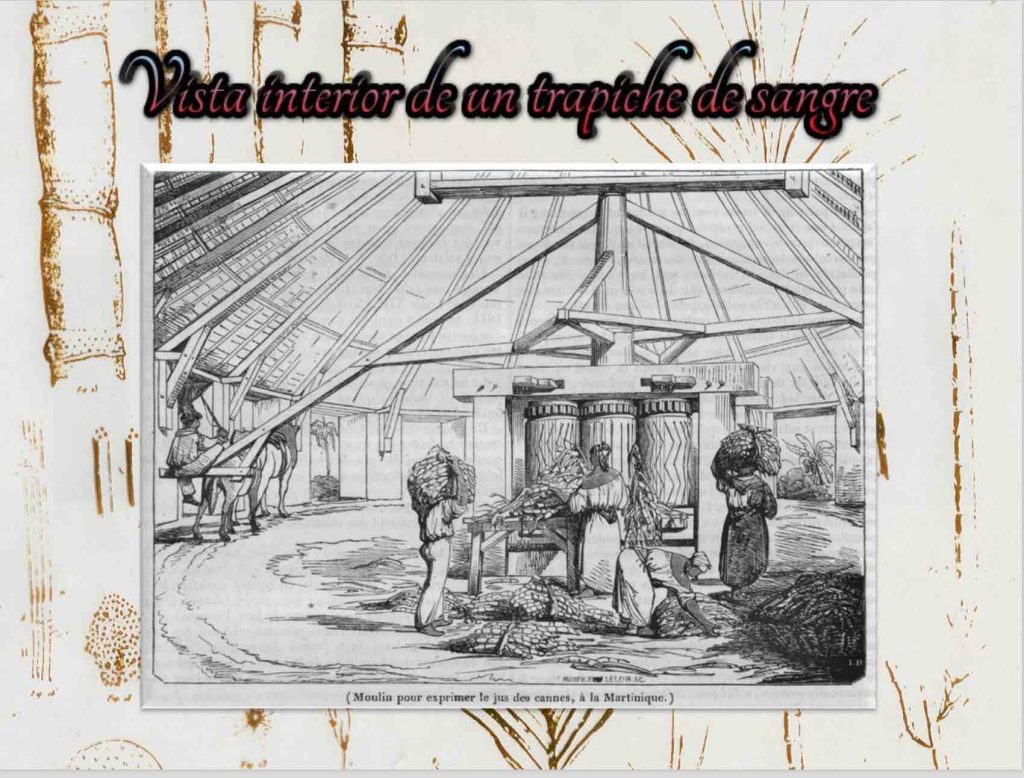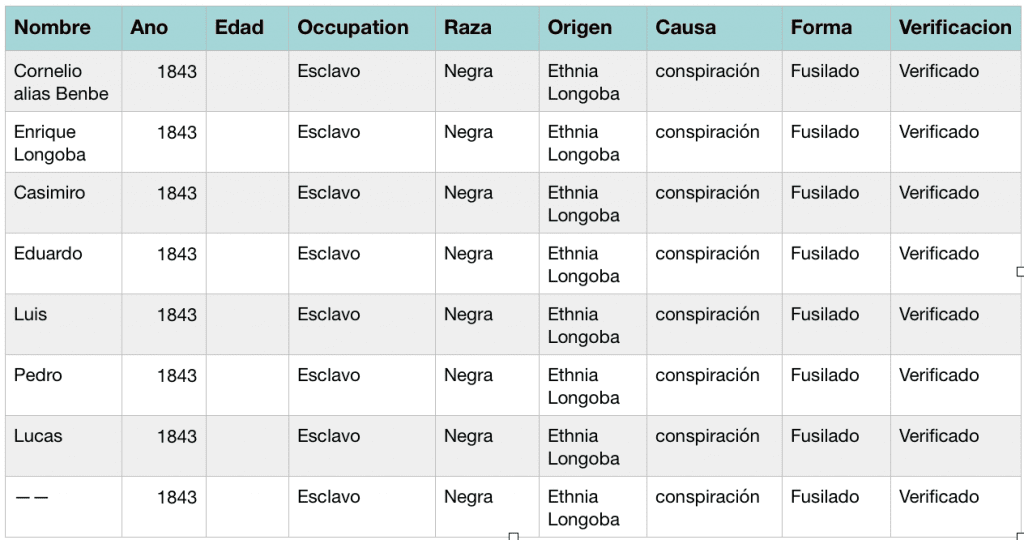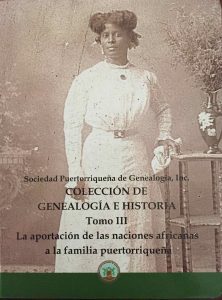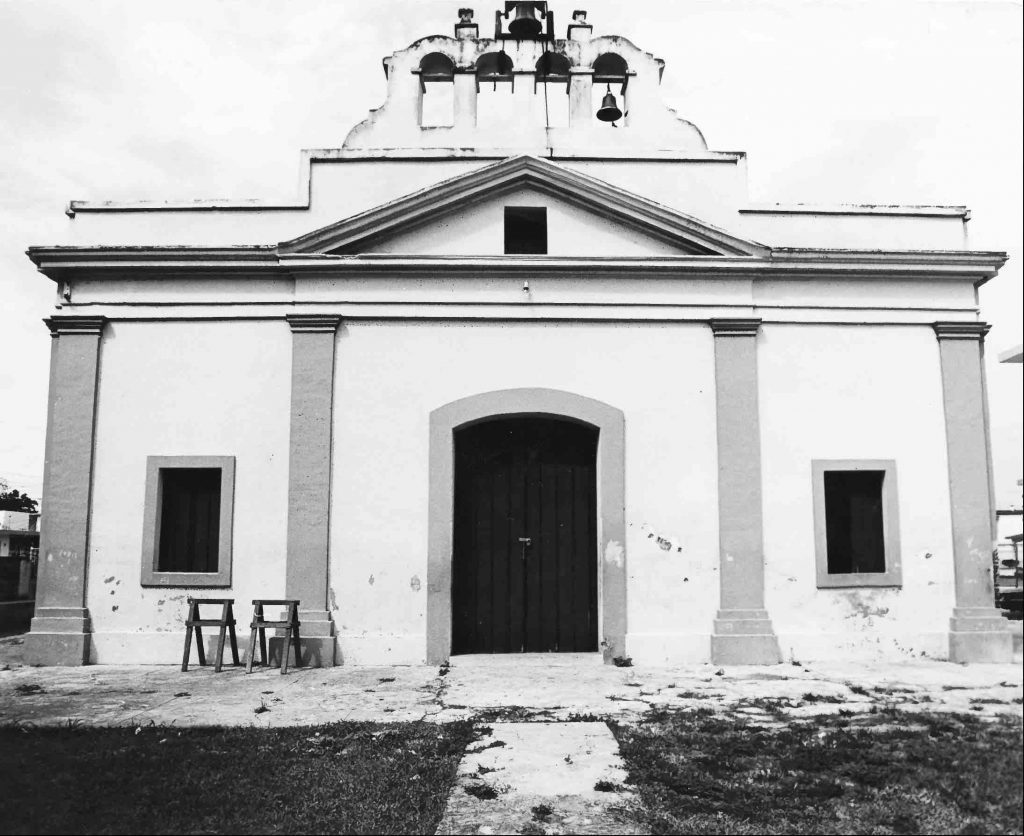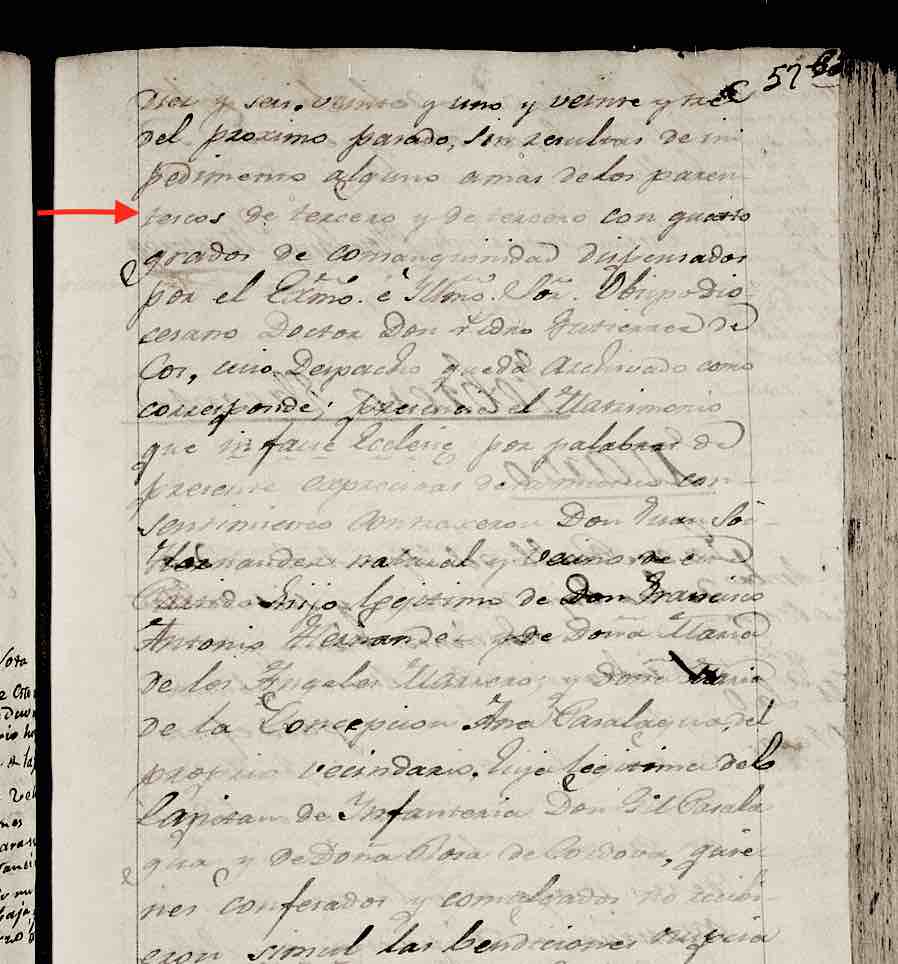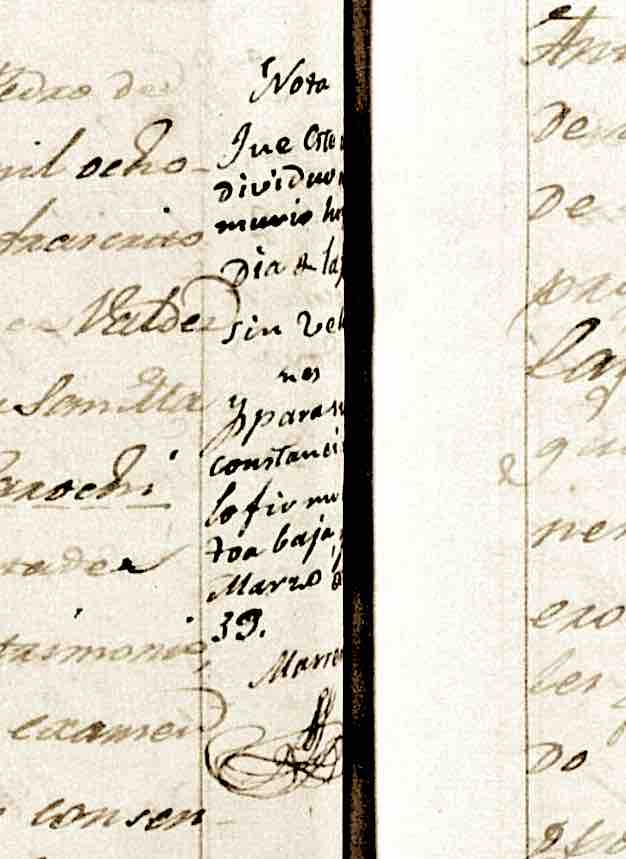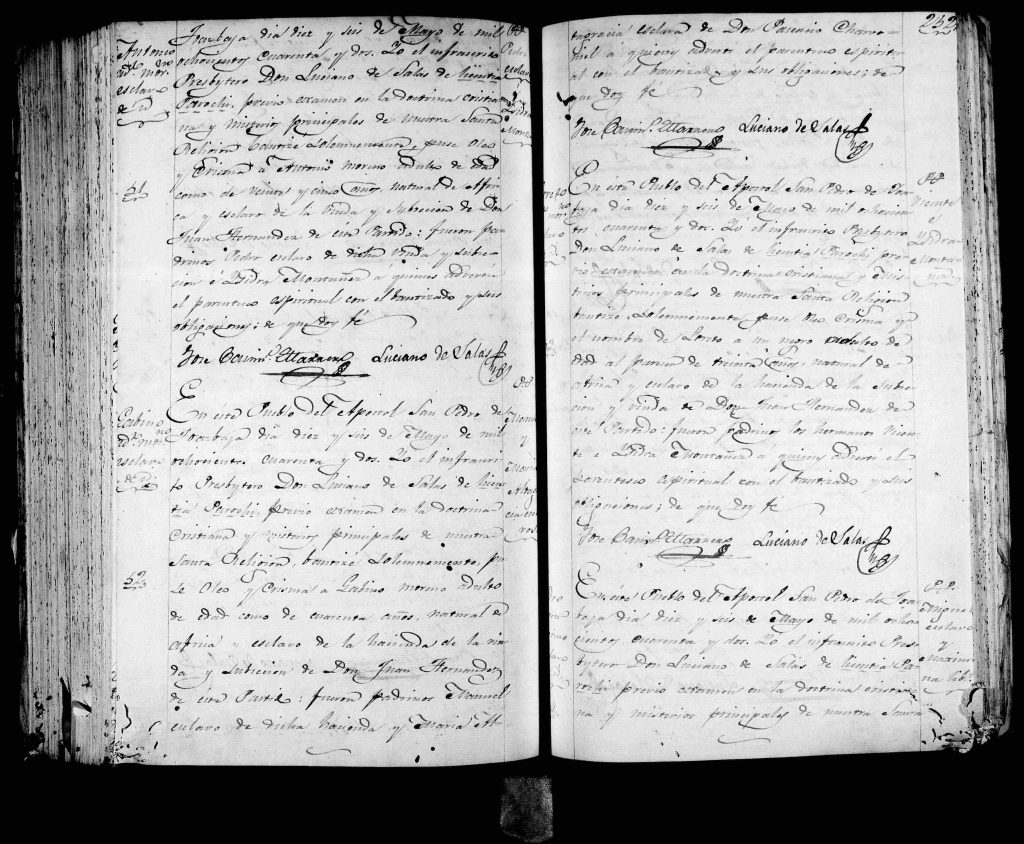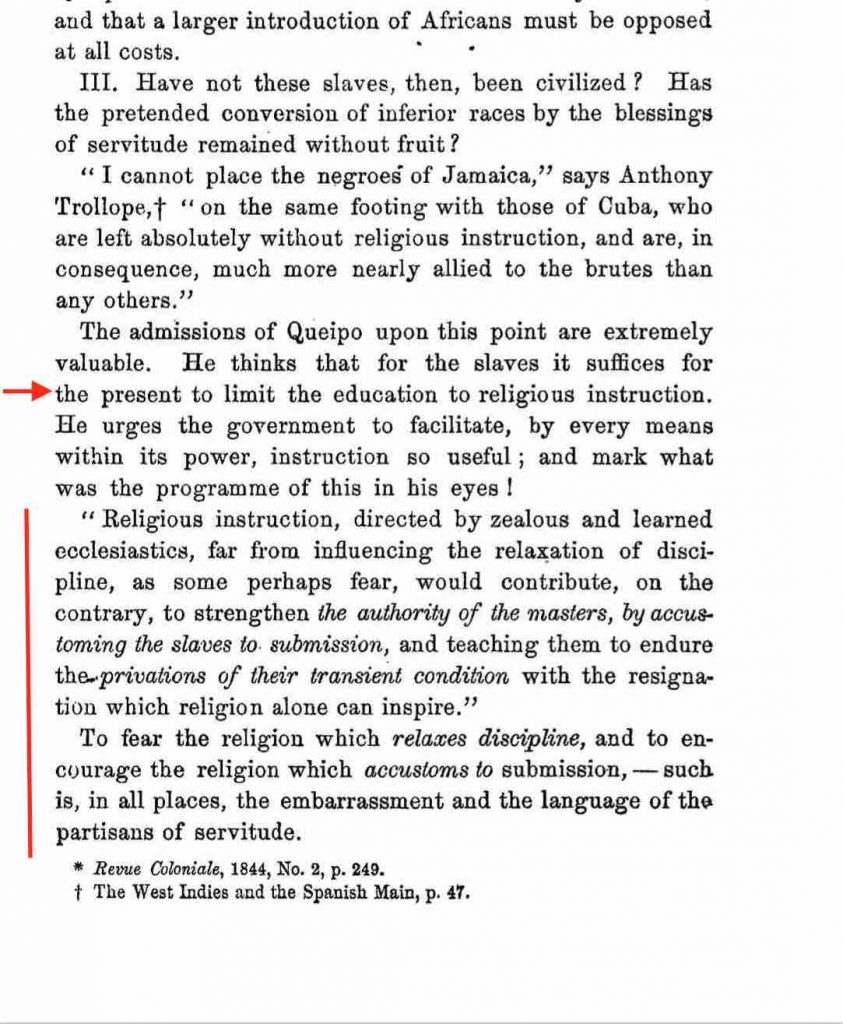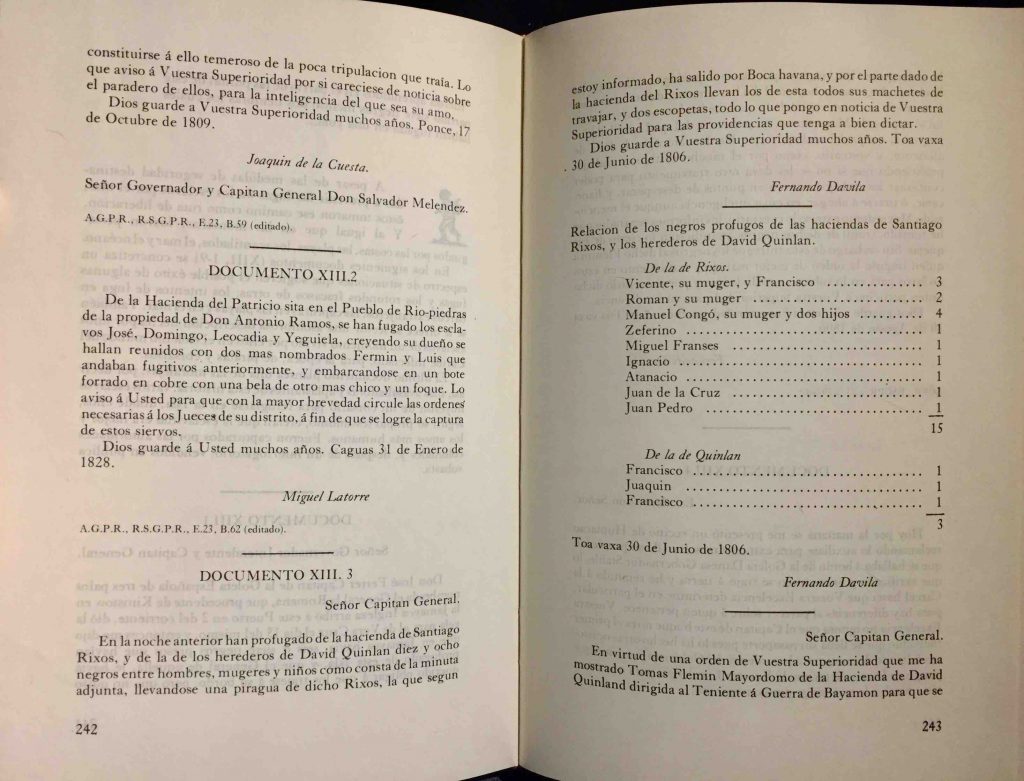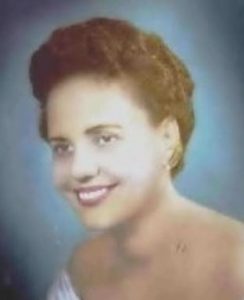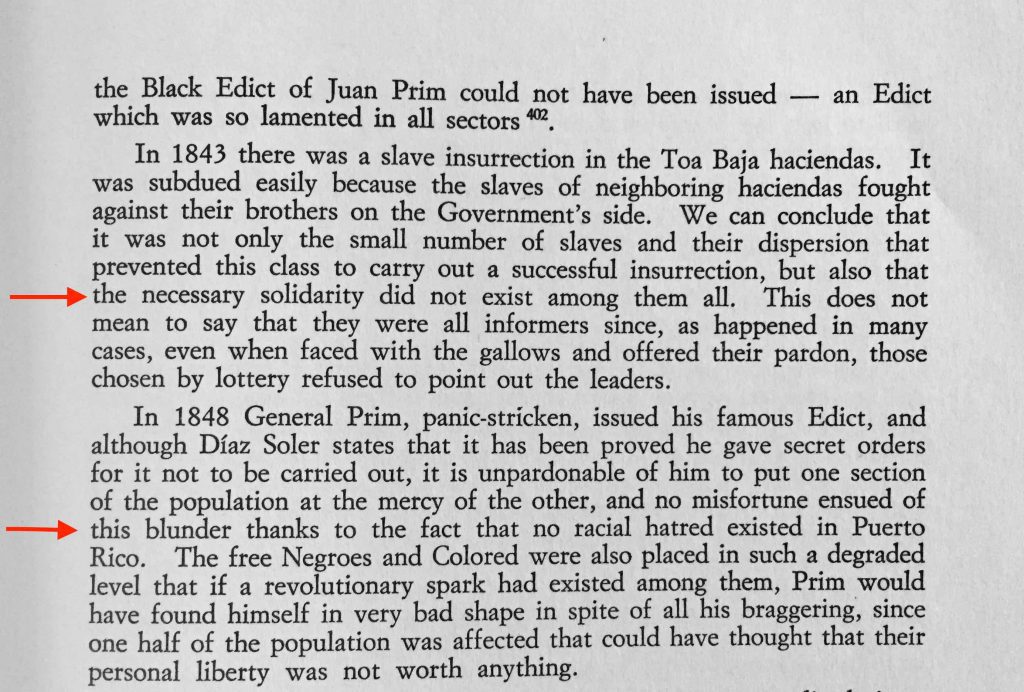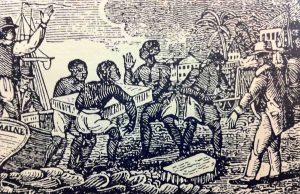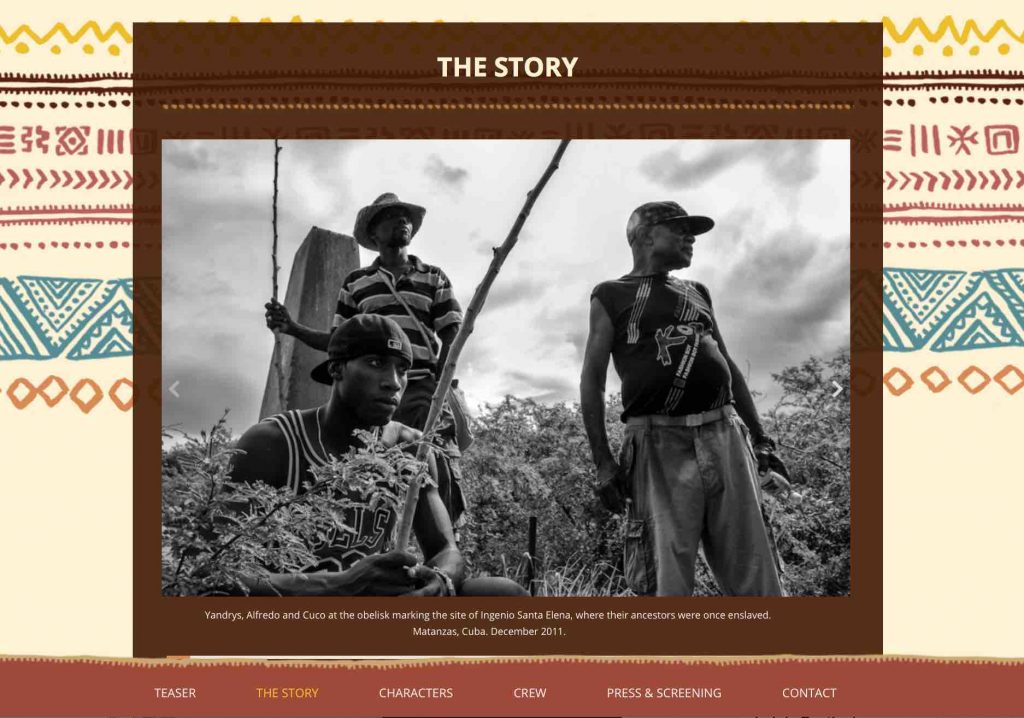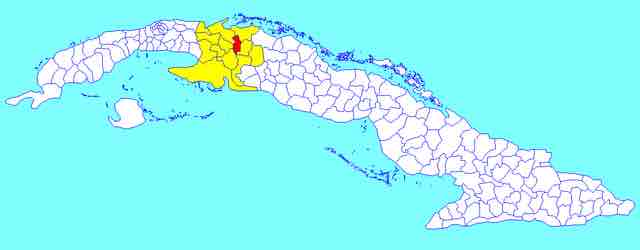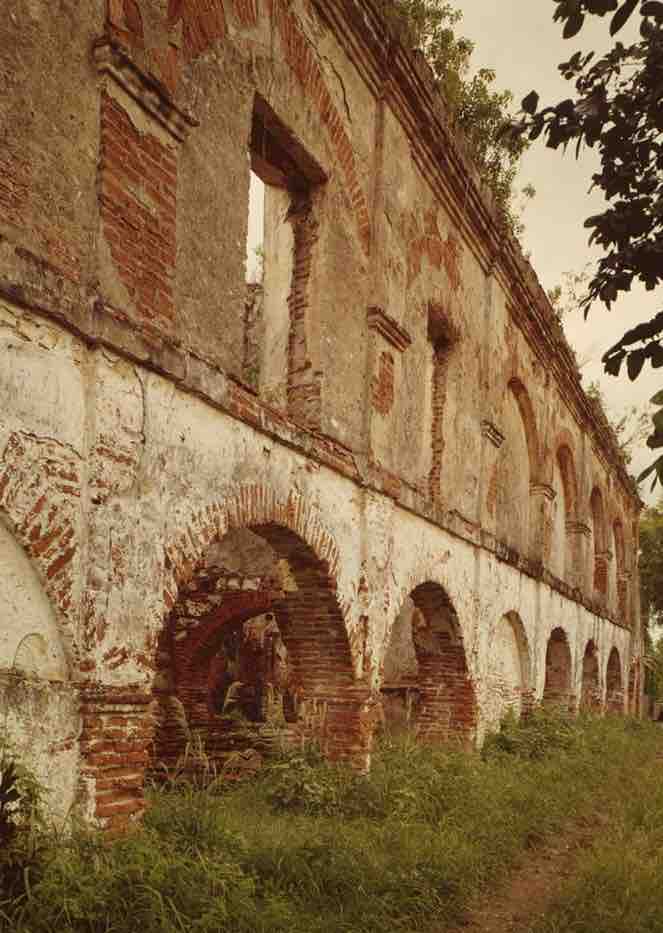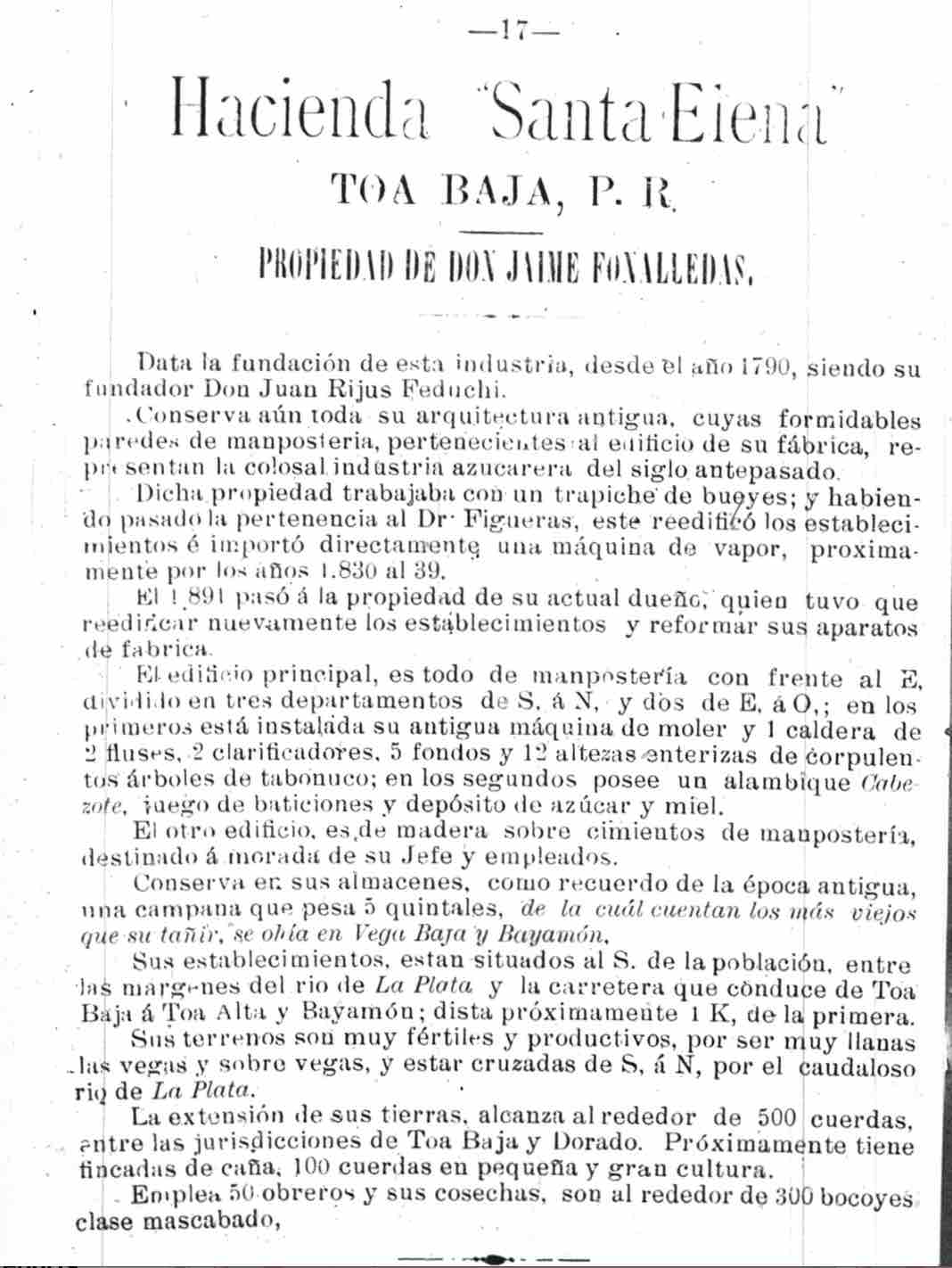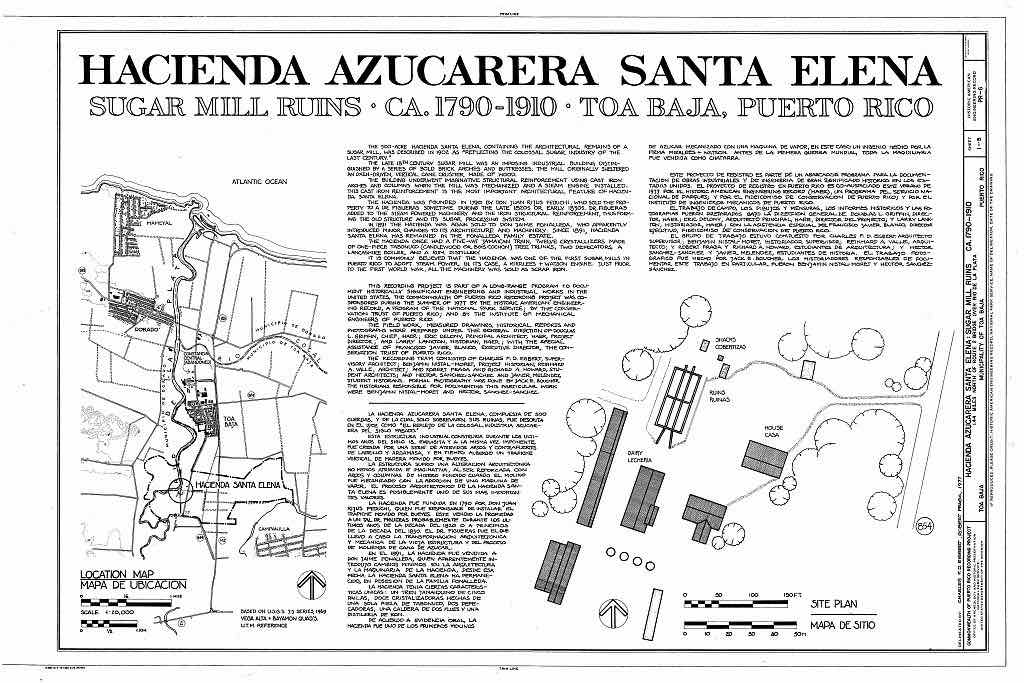“Anuncios”
In December 1842, after much planning, Juan de la Rosa finally decided to do something about his situation. He took an old hat, the clothes on his back, and left the plantation of dona Andrea Gonzalez de la Cruz in the rural Barrio of Capa in Moca. This was maroon resistance, and the news of Juan de la Rosa stealing himself is one of the few advertisement for a runaway slave out of Moca, Puerto Rico in an official government newspaper. In this blog post I pull together a range of maps and documents, to reconstruct a glimpse of one enslaved ancestors life in 1842. Much of what I explore here are covers – those of landscape and of clothing,
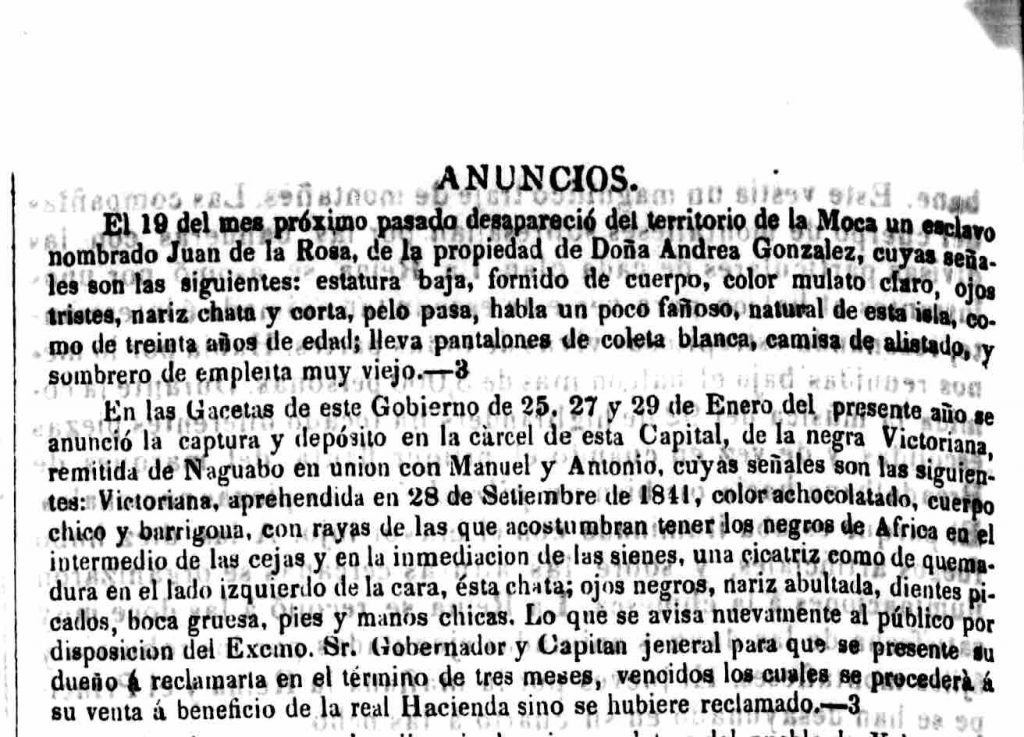
“ANUNCIOS.
El 19 del mes proximo pasado desaprecio del territorio de la Moca un esclavo nombrado Juan de la Rosa, de la propiedad de Dona Andrea Gonzalez, cuyas senales son las siguientes: estatura baja, formado de cuerpo, color mulato claro, ojos tristes, nariz chata y corta, pelo pasa, habla un poco fanoso, natural de esta isla, come de treinta anos de edad; llevan pantalones de coleta blanca, camisa de aliado y sombrero de empleita muy viejo —3”
Translation:
On the 19th of last month, fugitive from the territory of Moca is a slave named Juan de la Rosa, property of Dona Andrea Gonzalez, whose details are the following: low height, developed body, clear mulato color, sad eyes, nose flat and short, tightly curled hair, has somewhat nasal speech, born on this island, about 30 years of age; is wearing pants of white linen, matching shirt and a very old woven hat. —3
The runaway slave advertisement from Moca, Puerto Rico in issues of La Gaceta de Puerto Rico, are few in number. At the moment I’ve located only one other advertisement from the 1830s. The three that appears at the end of the advertisement for Juan de la Rosa is an instruction to the printer for how many times the ad was run- 3 editions, with 3 issues weekly. It’s a question how much the ads cost to be placed, and the much larger question is the outcome. The specific dates spanned the weeks of holiday at the end of the year; the last week of December, 24, 27, 29, 31; the first week of January 3, 5 & 7, Jan 17, 1843.
While in Puerto Rico this kind of notice is not as copious as the numbers of runaway advertisements seen in some stateside publications, the Gaceta’s ‘Anuncios’ (announcements) column carried similar details regarding human and non-human property, so that notices posted by various slaveowners about runaway slaves appear along those of lost horses and livestock. Yet, what skill sets did Juan de la Rosa have? Was he a farm laborer or a carpenter? Was it that he was the bulk of the labor on the Gonzalez plantation? Apart from reclaiming scarce labor, what drove the slaveowner to place a notice?
This entry contrasts with the next runaway ad that appears below it, which is for an African woman named Victoriana who fled with two other men, Manuel and Antonio. Considerable time is spent describing her country marks- her ritual scars, along with the scars of abuse that mark her face and abdomen, filed teeth, dark skin, down to her small hands and feet. Victoriana managed to make it from a rural plantation in Naguabo to the capital of San Juan, where she was apprehended and jailed. The Governor and Captain then ask that the owner show up in three months, otherwise she will be sold and the funds used to benefit the administration.
That tight circle of property and sale also circumvent issues that today can be understood as the suppression of self determination through force exerted by agents of the state, the church and the slaveowners. For the most part, individuals and families who embodied the authority of one, two or all three institutions made their legal decisions in support of profit. Some freed people purchased their family members freedom, through the process of coartación, paying their owners full value in exchange for freedom. (For examples, see Gaining Freedom: gleaning narratives from Caja 1444, Moca, Puerto Rico, 1848-1854)
Who was Juan de la Rosa?
As is often the case with working with enslaved ancestors, there is more to be gleaned about the person who held Juan de la Rosa in bondage, than Juan de la Rosa himself. Yet there are some key details to consider: he was born about 1812 in Puerto Rico, and likely in Moca. Juan de la Rosa was short, and had a distinctive, nasal way of speaking. His skin was not mottled, but a clear, light brown color that spoke to admixture, with no distinguishing scars or problems mentioned. Given his age in a previous record and identity as mulatto, there remains a possibility that he was related to the Gonzalez or the Morales families. In terms of racial categories, consider that the terms used to identify Indigenous ancestry were reduced to colors, with high percentages of AmerIndian mtDNA haplogroups today, it’s possible that this is also part of Juan de la Rosa’s blended ancestry.
Hair texture was a detail noted in documents, a barometer of sorts for the potential to pass or escape notice. Like many people of African descent, Juan’s hair was tightly curled. The term pasa comes from the Spanish word for raisins or currants, not pasa as in the verb pasar, that means to pass or go. A hat would help buy time and delay being identified by authorities, however on some plantations about this time, enslaved workers were given red hats, visible from a distance.
Recently, a series of articles on-line discussed the use of braiding cornrows in various patterns to communicate imminent departures to a literal representation of a pathway out. [2] One wonders what modes of communication supported Juan de la Rosa’s escape from slavery in a rural area.
Petit Marronage = Diasporic Marronage
Put it down to timing. Juan de la Rosa likely received an allotment of clothes, and, as by December the harvest was over, he decided to make his escape as the season of celebration just got underway. The dry season had begun, rain was less than in November and after December, rainfall would be low for the next two months. By traveling during the long religious holiday that extends from early December to early January, runaways took advantage of long nights, gatherings and celebrations where they might blend into a crowd, gain resources and information. Juan de la Rosa left under a full moon that began two nights earlier on 17 December, affording him light to make his way. [3]
There is no mention of shoes in Maria Andrea’s notice; he like many, went barefoot. What is clear is that Juan de la Rosa got to the point where he valued his life enough to risk it, leaving everything to get his freedom through an act of petit marronage. This act, as historian Jorge L Chinea noted, “hit the slaveowners where it hurt most: in the pocket… paralyzing or shutting down production and depriving owners of their labor force.” The maroons became thorns and pricks in the colonial regime’s side. As Chinea points out this networked movement of those who freed themselves, this resistance, had a larger social impact that disseminated culture and influenced colonial and intercolonial affairs, which he terms, ‘diasporic marronage’.[4] Juan de la Rosa was part of a larger group of people who decided on freedom by any means necessary.
Finding Juan de la Rosa in other documentation
He is likely the same as Juan age 10 listed in Moca’s 1826 Relación de Esclavos. As mentioned before, this was an island-wide inventory of the humans held in bondage. It was done in accordance with the recent passage of the 1826 Reglamientos, a new slave code issued by the Spanish government, a the guidelines that outlined the rights of owners and the enslaved. Fortunately the 1826 Relación is not a numeric list, and has details such as name and age. Listed with Juan are Maria Antonia age 6 and Isabel age 4, close enough in age to potentially be siblings-(starred in the chart below). [5]
As small slave owners formally and informally sold enslaved people to family and neighbors, enslaved families could potentially live nearby. Another chart, Tabla XI. Parejas de esclavos en Moca para el siglo XIX. by Nieves Mendez, based on baptism and marriage parish volumes between 1786-1813. Among the 15 slaveowners is Maria Morales, who held in bondage the couple Felipe and Juana and their two children, Maria Antonia and Juan de la Rosa towards the start of the nineteenth century [6 ]
Juan de la Rosa’s parents, Felipe and Juana were likely married, and their children baptized in keeping with earlier versions of the Reglamentos. As owners of eight enslaved people, Maria Morales and Manuel Gonzalez were among the larger slave owners in Moca. [6] In 1782, they lived in Ojo de Agua, an area in the south of Aceitunas, today known as Ojo de Valencia, and the property was still there into the 1830s. They are likely descendants of earlier military families such as the Morales del Rio and related lines that extend to older settlements such as Arecibo. Maria Morales (bca 1755) was married to Manuel Gonzalez (bca 1770), and their 5 children were: Andrea, Manuel, Ynes, Rosa ‘Rosalia’ and Juana Gonzalez Morales.
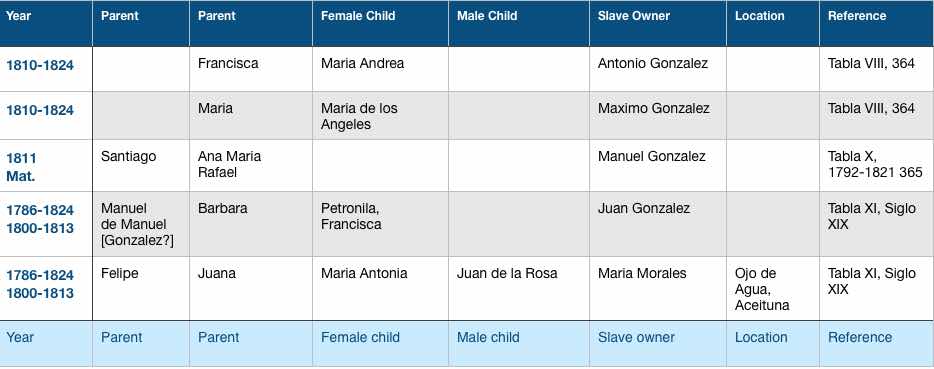 Enslaved persons owned by Gonzalez & Morales Slaveowners, 1775-1824
Enslaved persons owned by Gonzalez & Morales Slaveowners, 1775-1824
Notes for this Table 1775-1824: line entries record information from each table and some persons appear more than once. Relationships between Gonzalez remain to be clarified.
Information from Tables relating to enslavement, Antonio Nieves Mendez, Historia de un pueblo: Moca 1772 al 2000. lulu.com, (2008)
Tabla VI – Esclavos y esclavistas de Moca, 1775-1785. 347.
Tabla VII – Esclavos y esclavistas de Moca, 1800-1810. 361.
Tabla VIII – Esclavos y esclavistas de Moca, 1810-1824, 361-364
Tabla X -Identificacion de matrimonios de esclavos registrados por la Iglesia de Moca 1792-1821. 365
Tabla XI – Parejas de esclavos en Moca en siglo XIX. 365.
Tabla XI data based on parish books of Iglesia de Nuestra Señora de la Monserrate, Moca:
L2 1786-1813 Mat
L3 1813-1824 Mat
L5 1800-1810 Baut
L6 1811-1813 Baut
Information provides the identity of Juan de la Rosa’s family: his parents Felipe and Juana, and sibling Maria Antonia, at Ojo de Agua in Aceituna before 1813. By 1826, Juan, Maria Antonia and Isabel (with ages that vary by 3 years) are listed as slaves of Andrea Gonzalez, who has the estancia Guamaes in Capa. By December 1842, Juan de la Rosa departs. The transfer of enslaved persons occurred by inheritance or purchase, perhaps prompted by the death of Maria Morales, Maria Andrea’s mother. The children’s parents, probably born in the 1770s, may have died or were sold by this time. There is likely more documentation in the notarial documents of the Archivo General de Puerto Rico
Those not included in the charts
In January 1810, Manuel Gonzalez gave his mulata servant Dolores, 25 years old, her liberty after she paid 200 silver pesos for her freedom. In October 1811, Manuel Gonzalez traveled to Aguadilla to purchase from Pedro Ferrer, the enslaved servant Felix, 25 years old and born on Puerto Rico. Two weeks later, he purchased Geronima de la [roto] a servant 29 years old who Antonio Hernandez of Cabo Rojo had inherited from his mother. These transactions involve either Manuel Gonzalez, husband of Maria Morales or their son, Manuel Gonzalez Morales, who married Rosa Hernandez, and then his second marriage was to a —- Vazquez Vega. Each of the Gonzalez Morales children likely benefitted from the continued accumulation of property both human and material over time. [7]
Historian & genealogist David Stark found that “more than half of these marriages in Caguas, San German and Yauco involved slave shows owners were linked by ties of the first degree, that is, the owners were either siblings, a parent and child and son or daughter in law.” [8] This enabled the informal lending of enslaved family members from one plantation to another, and created an existence where they lived “within two family cycles: their own and that of the masters.”[9]
By 1826 there are 3 Manuel Gonzalez in the 1826 Relacion de esclavos– either the same or related persons owning property in two different barrios, Capa and Aceituna. By 1826, those enslaved ancestors that appeared in the parish records— Juana, Maria Vicente, Juana Simona, Marcelo, Maria Victoria, Santiago, Ana Maria Rafael — do not appear, either due to sale or death. Felipe may appear as widowed in later documentation. In 1826, the Felipe owned by Manuel Gonzalez is some two decades too young to be the father of children with Juana (who does not appear in the census) regardless, by 1826, they are owned by Andrea Gonzalez. Just as in Parnaiba, Brazil, most slaves who married off their masters estates had partners among their extended family. This in turn, increases the likelihood that owners were related.
Mapping out information about enslaved ancestors across documentation provides suggestions for exploring specific relationships, establish timing and location to build out nodes of data that can help extend branches of family trees. This also supplies additional insight into female slave ownership in Puerto Rico.
The 1826 Reglamentos
In 1826, Governor don Miguel de Torre issued a long document intended to regulate the treatment of the enslaved. The passage of the Reglamento sobre la education, trato y ocupaciones que deben dar a sus escalos los duenos y mayordomos en esta Isla, 12 agosto 1826 [11] addressed common complaints, issues and provided a detailed standard for treatment by slave owners in its sixteen chapters. More importantly for genealogists and family historians, this law also culminated in an island-wide census that enumerated and centralized information on slaves in Puerto Rico.
The 1826 census of the enslaved also intended to account for the porous population of African and Native descended people who fled from slavery to form free communities. It also helped the Spanish government get a handle on the ‘informal’ slave trade after 1808, the year the British declared an official end to the traffic. Spain’s subjects in the Caribbean continued to purchase people up until the official end of slavery, 1873 in Puerto Rico and 1886 in Cuba. [13]
Capitulo V of the Reglamento specifically speaks to the collection and storage under lock and key of farming tools at the start and end of each day, lest the tools be taken up in an insurrection. [12 ] In this case, fears about the power of enslaved labor collided with a growing awareness that the same force could be channeled against the powers that be. The struggle for abolition was advanced by multiple forms of resistance, of which running away was one. Movement was controlled, visits to other plantations limited, trade with another enslaved person on plantations were prohibited in Capitulo VI, and diversions, separated by gender within prescribed limits were outlined in Capitulo VII. The facets of the law reveal white fears about resistance and violence, just as it prescribed and justified the use of violence as a cultural and social resource against the enslaved.
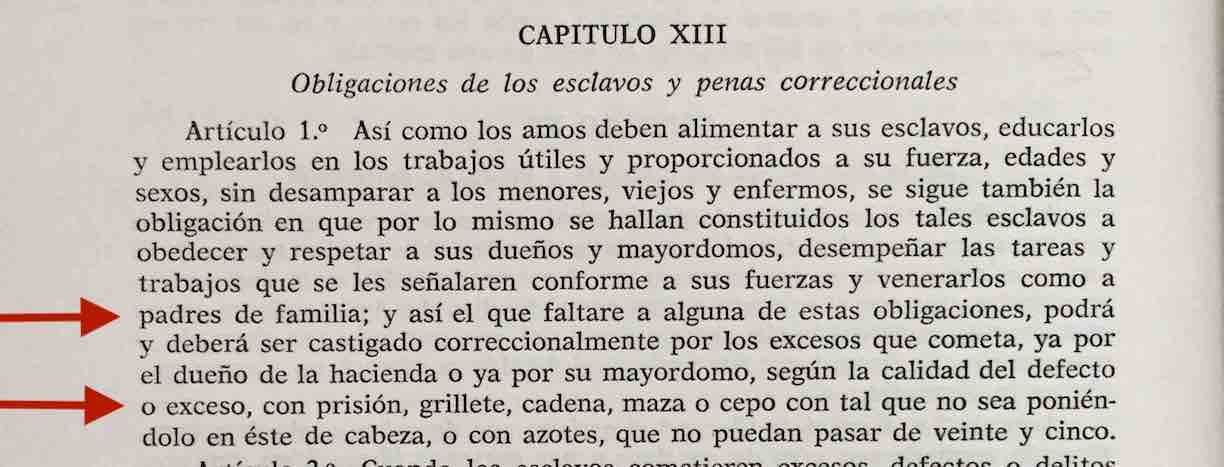
Capitulo XIII: Obligaciones de los esclavos y penas correccionales outlines the obligations a the enslaved had toward a master and lists the punishments by the owner or his majordomo. Given the required ‘obedience and respect’ leaves questions as to how perception and interpretation of responses led to any number of punishments: prison, shackles, chain, mallet,
or stocks, or by whipping, limited to 25 strokes. [13]
This pattern of using violence ties back to elimination as a feature of the process of settler colonialism, where murder, multiple diasporas and displacement of populations pushes against the desire and right to self determination. What this document does not specifically address is the fallout of this system— trauma, the constant threat of death, persecution, hunger, illness, assault and rape that are blind spots in earlier Puerto Rican historiography. By delving into multiple sources one can work against the erasure and denial of elements of a system with structures that remain in the present for POC. Revisiting these contexts is key for gleaning details that can connect an investigation or a narrative further.
As historian Milagros Denis wrote: “In Puerto Rico the slave population revolted. They caused fear and chaos. The white elite were afraid of blacks. By rebelling, the slaves made the unthinkable and the unexpected. They broke up the racial and class hierarchies embedded in the island’s colonial system.” [14] This was despite Articulo 2ndo, Capitulo XI, which awards liberty to any slave who discovers and reports any conspiracy either by other slaves or free people that aimed to disturb the pubic order, or kill the owner, his wife, son or father of the owner. Freedom was to be paid by the body of hacendados, and an additional reward of 500 pesos given with a public notice. If the denouncers were many, the money could be subdivided, but individuals would have to pay for their own freedom. [16]
Denis’ observations in her review essay on the repercussions of resistance on racial and class hierarchies connects to how history was written— mostly disconnected from any effort to offer critiques that could effect real change. Historian Ileana M. Rodriguez-Silva speaks to the role of gratitude and deference in post-abolitionist thought of the 1870s, a distortion that served to “rearticulat[e] white superiority and patriarchal authority”.
What “Political practices such as gratitude highlight [are] the liberal features of benevolence and paternalism and undermine efforts to critique the structures of power, especially through critiques of racialized domination. Paradoxically, creole political leaders and intellectuals minimized slavery but felt the need to celebrate abolition, by which they constantly rewrote the history of slavery.” [17] By the 1940s and 1950s this view accompanied assurances that slavery in Puerto Rico was mild in comparison to Cuba or the American South, a recycling of views from a century before. Colorism mutated over time.
Taken as a whole, the Reglamentos of 1826 was an attempt to address every aspect of keeping persons in bondage, its chapters turning from clothing to health to work day, the restrictions on pregnant women and nursing, the standards are suggestive of the wide range of conditions and violations that led to the creation of this document. It justified the separation of mothers from the care of newborns, in a house or hut with other children cared for by one or two women. [18] Yet its standards were often expressed as if they were ideal, which some writers, like the pro-slavery apologist Colonel George A Flinter wrote of as a mild form of slavery, with many possible ways to generate income from the enslaved and their agricultural labor. This is the industrialization of the body.
The 1826 inventory of enslaved people listed slave owner, names of the enslaved and their ages. The next inventory, the Registro de esclavos came a half century later, in 1870. Both the 1826 and 1870 Registros are of great benefit for genealogists and family historians as both documents cover every municipality on the island (in one form or another), and more importantly, the inventory is not numeric, and can be cross referenced with other sources.
Still, I’m left with a question- how well did slave owners follow a 16 chapter document that attempts to address all aspects of slavery when literacy was below 20%?
1826 Registro de esclavos, Moca
A transcription of the 1826 Registro de esclavos is in Antonio Nieves Mendez’ Historia de un pueblo: Moca 1772 al 2000. This registro has the names of the enslaved and their ages, but does not include the locations for each slaveowner. Extracted are those enslaved owned by Manuel Gonzalez and Andrea Gonzalez; I added an estimated year of birth for each person.
The organization of the names on the list suggests parental relationships, for example, Maria 30 and Petrona 3; Maria Ramona 30 and Ramona 7 and Dolores 5. Manuel Gonzalez’ name appears three times in the Registro, and it is unclear whether this is one, two or possibly three individuals. Under Maria Andrea Gonzalez are the children Juan, Maria Antonia and Isabel, which corresponds to the information from the parish records above, the children of Felipe and Juana. The fact that only the children appear is likely due to a transfer of their ownership through inheritance from her mother, Maria Morales.
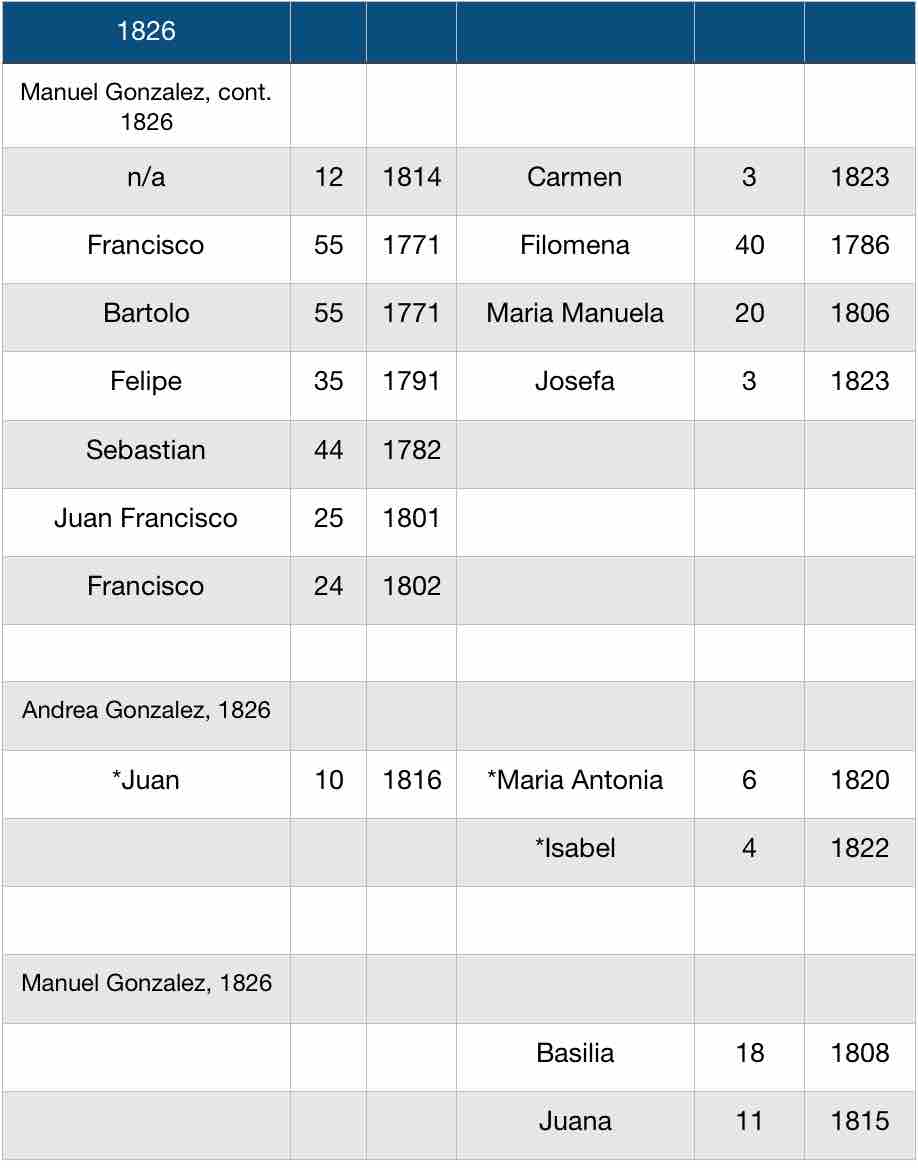
The total number of enslaved people listed in the 1826 census is 684 souls, with a higher number of males the total number of women, 318 to 266. [18] The 1847 Censo de Riquezas lists the number of enslaved persons in each barrio; for Aceituna, the number was much higher than for Capa. The list shows how several estancias combined resources in the production of coffee, a crop suited for the region. In 1826, this organization and concentration of production was just getting started.
Location, location, location: Fugitive landscapes of NW PR
Two areas figure in this narrative— the south of Aceitunas and within the center of Capa, circled in the image of the barrios below. Over the course of the decades, colonial administrations became more specific in identifying crops, yield and values.

The censo and riquezas became more detailed as did the legal structures of enslavement, which were refined and redefined each time Reglamentos were issued. We can better understand the constraints on the lives caught in these cycles of rights, production and profit, as we trace these ancestors. Familial relationships connect in myriad ways within an economy based in slavery.
In 1847, Andrea Gonzalez owned the estancia Guamaes, in Barrio Capa, where there were 38 estancias and one hacienda, named La Suerte owned by Tomas Roman. Neighboring owners had different uses for areas of land that ranged from mono-crops of sugar, coffee, cotton or tobacco, to the subsistence crops of ‘frutas menores’ or pasture. The need for labor whether free or enslaved, depended on the crop and amount of land. For example, in 1847, Roman owned 4 people and had 20 free peons working some 22 of 133 acres of land. In contrast to Roman, Gonzalez had 3 of 8.5 acres worked by one enslaved person and one peon. Size wasn’t necessarily an indicator of slaveholding— even Gregorio Velazquez with 6 cultivated acres of 130 acres, he only had two peons working his farm. [19]
The small number of free and enslaved people in Moca helps to delimit the possibilities when identifying a person. Also consider there is only one consistent family unit. As Maria Morales disappears from the subsequent list by 1810, she is most likely Maria Morales born mid-century, married to Manuel Gonzalez, who had five children before 1780.
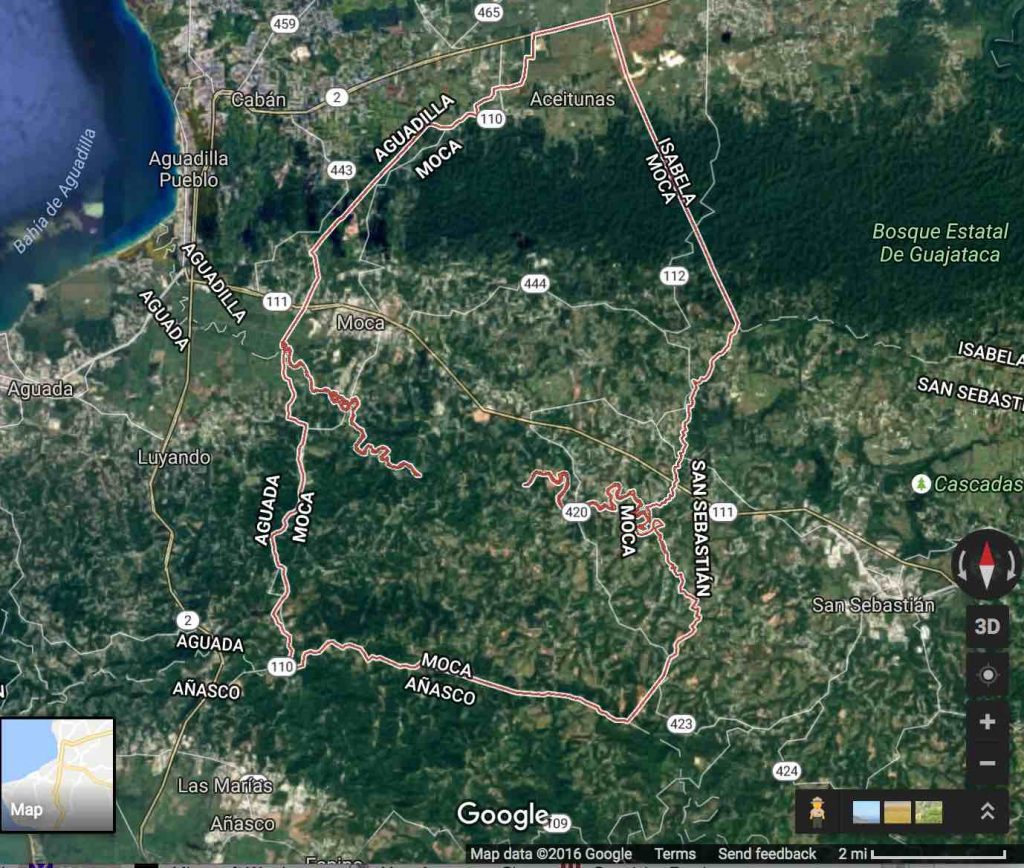
The Google satellite map above shows that part of the landscape consists of ridges that to the north rise into the Cordillera Central, with the Bosque Estatal de Guajataca (Guajataca Forest) just a few miles north of Capa.
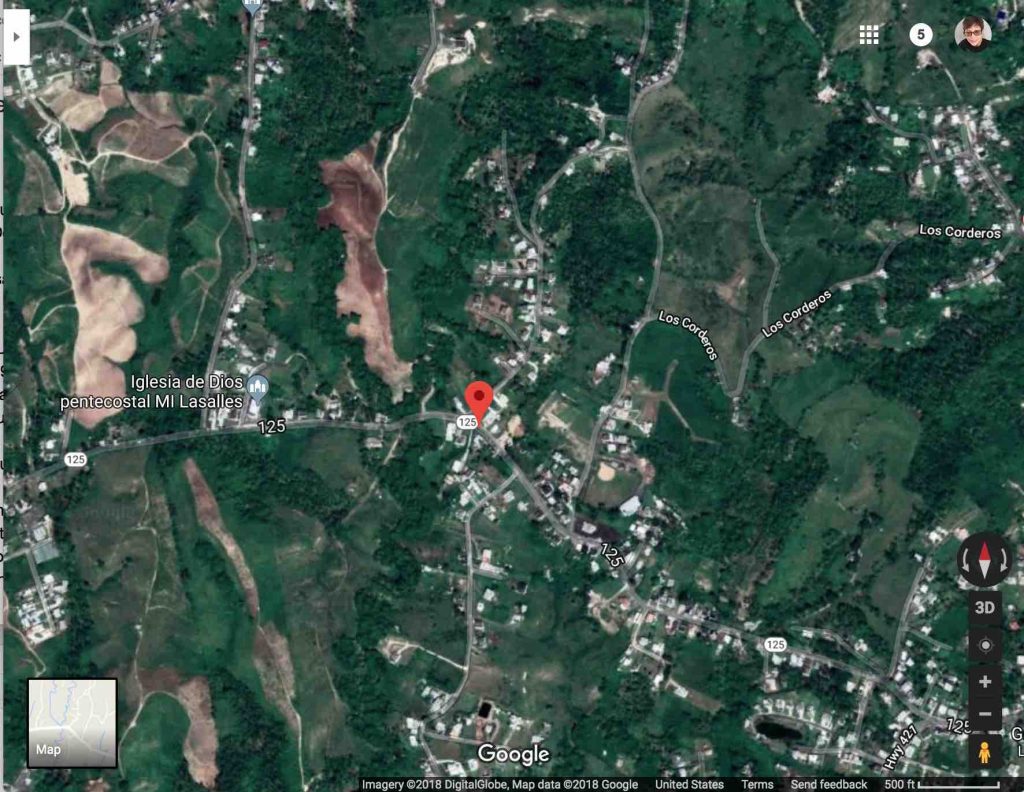
The close up satelite images in these Google Maps shows the ridges that comprise much of where the homes are in Capa today. That bears comparison to the topographic 1889 Military Map, the Itinerario de San Sebastian a Moca. [20] These hand drawn, hand-inked maps are full of details useful for understanding the topography of the Cordillera and how people navigated these features.
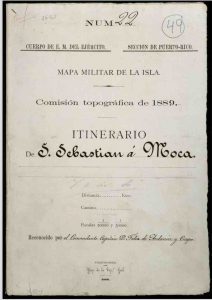
In the full sized screenshot of the map below, the area of Barrio Capa is indicated by a red rectangle just off center, and the road that extends from left to right is today designated Rte. 125. Next, compare the Google Map image with Rte. 125, the road that extends East and West of the red marker, with the rendering of the road some 129 years before in the military map; litte has changed. The first image shows the entire stretch from Moca’s border with Aguadilla on the left, and San Sebastian on the right, as mapped by Spanish colonial military; the image below is the demarcated area that shows Capa in detail.
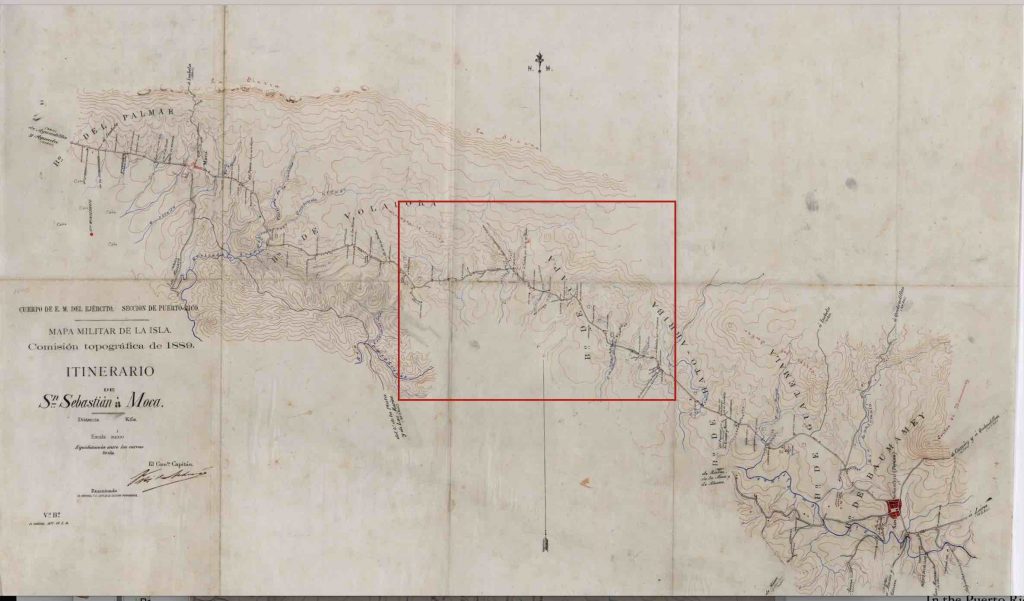
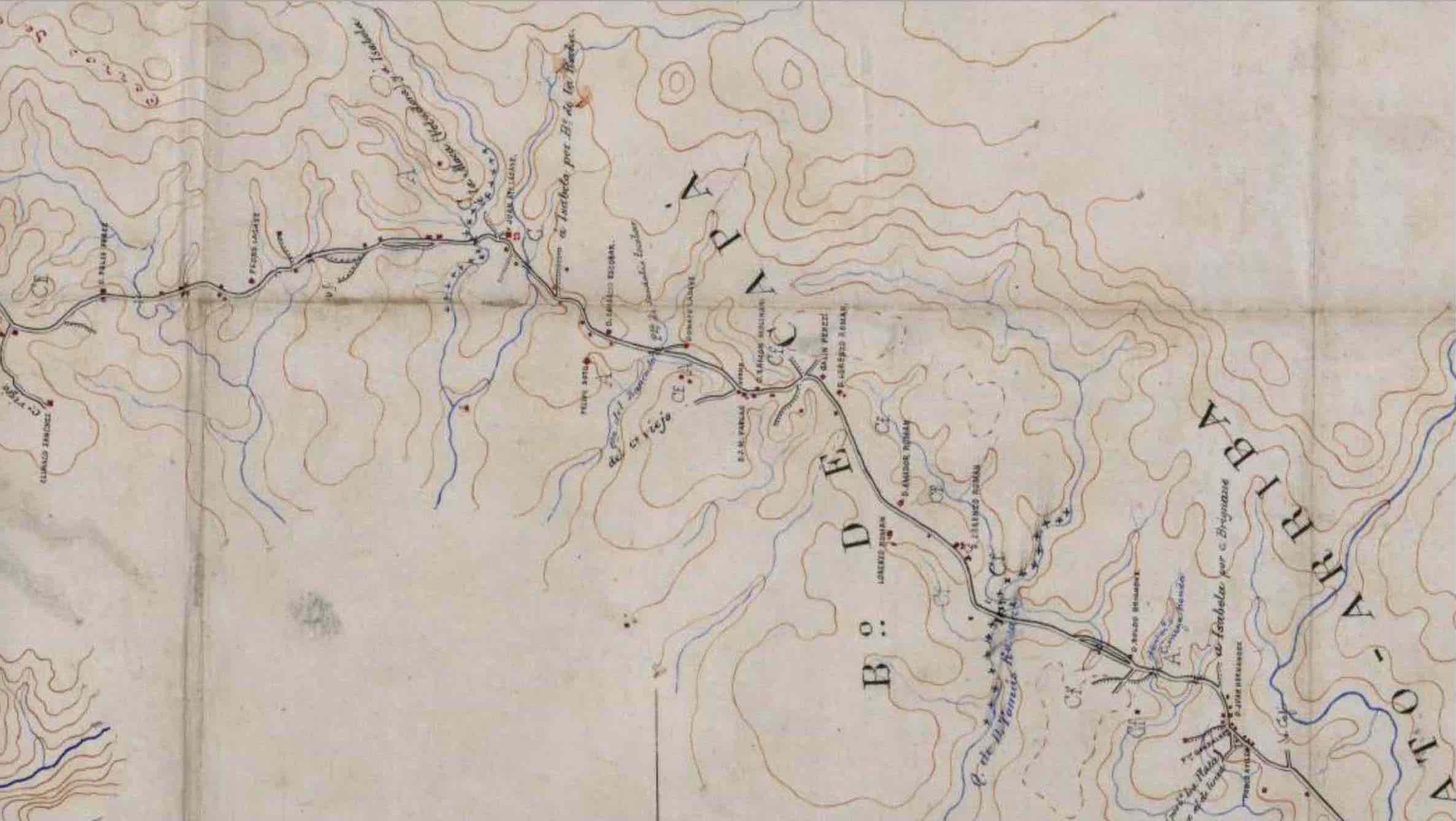
What’s interesting about both maps, (available on ISSUU.com) are the names attached to features and to property. The names on the 1899 map Itinerario de S. Sebastian a Moca, indicate the names of then property owners in Barrio Capa . On the map are Pedro Lasaye (Lassalle) Donato Lassalle, D. Salazar Escobar, Felipe Soto, C Ramon Molinari, SMJ Vargas, Galin Perez, D. Lorenzo Roman, D. Amador Roman. One consistent surname from the past here is Roman.
Las rutas del Norte
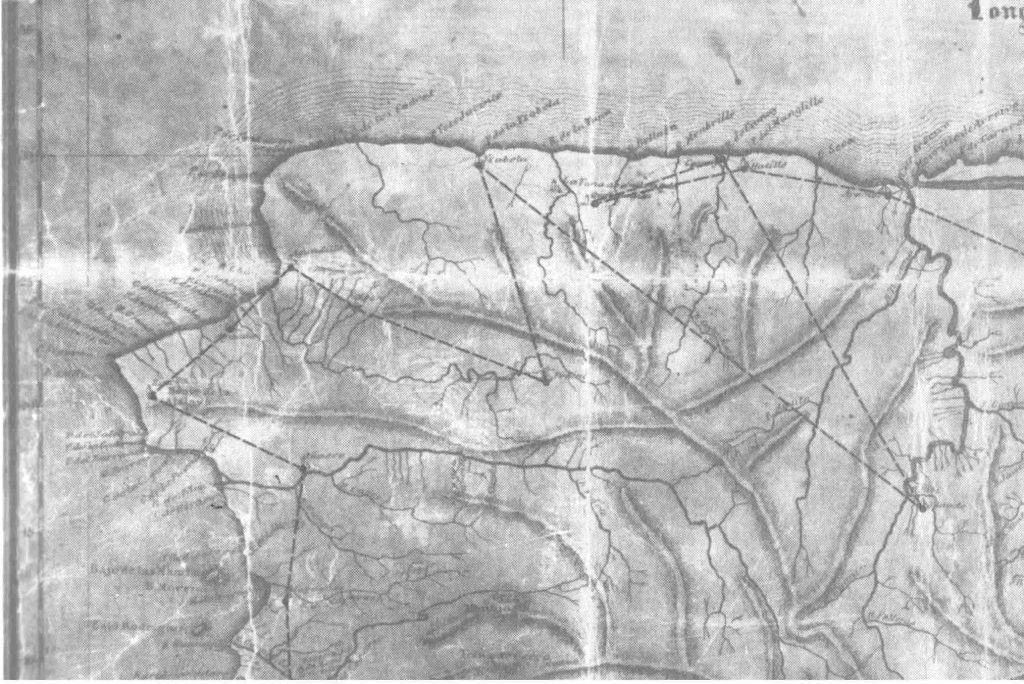
In Benajmin Nistal-Moret’s Cimarones y esclavos prófugos, from which this image of the 1837 map is taken, are notices from 1831 that warns the soldiers stationed along ‘La ruta del Norte’, about escaped slaves. Various Teniente a Guerra of each village received official news & notices from the capital of San Juan or directives from elsewhere along these routes. [21] The ridges of the Cordillera were considerable features that determined access and the kinds of crops that farms and plantations grew.
How this landscape was seen by some in 1837 is revealed in this map of La Ruta del Norte, Sur y Este. The region was known to be permeated by water, whether sea, creek, river or tropical rainfall, the northern route that connected the municipalities around the island were for the most part, narrow dirt roads that were eventually widened over time. The ridges of the Central Cordillera sweep from east to west, and the military road cuts across it. One function of the map is to suggest the potential reach of the official government, yet, the administration’s reticence to publicize or emphasize loss, the later absence of pertinent documents on organized slave resistance encountered in archives by historians, taken with the sheer density of the forest both then and now, contradicts the ideal of an efficient all powerful colonial military.
On the 1837 map above, Capa, Moca falls within the narrow end of “V” that straddles the NW corner of the island. The port city of Aguadilla is on the West and Isabela on the North, bisected by a river that meets with the town of El Pepino (San Sebastian)- (just off the center of the Visible is the part of the small mountain range, the Cordillera that rises up into Isabela. These three locations were major towns tied to agricultural production, and in Moca, thirteen creeks feed into the Rio Culebrinas, making areas impassable during the rainy season.
If one could reach water, or travel a safe route known to few, there was hope of getting beyond the reach of authorities. Some of the locations that runaways escaped to were the port cities of Mayaguez and Ponce. The changing landscape meant removal of vegetation and forests that served to hide Maroon communities, that likely existed at different locations within the Bosque Estatal that includes karst caves. If there was no direct escape to water, the next strategy getting to a free community and becoming part of it.
The other area that Juan de la Rosa knew from his childhood was Ojo de Agua, in Aceitunas, a barrio to the north between Aguadilla and Isabela. His parents Felipe and Juana, and his sister Maria Antonia, were enslaved by Maria Morales, the wife of Manuel Gonzalez. They appear in Ojo de Agua in 1782, and the plantation continued until its purchase in the 1830s by Juan de las Nieves, and subsequently became Ojo de Valencia, the expansive coffee plantation owned by Francisco Cirilo de Acevedo in 1844. He added another 1200 acres in 1866.[22]
In 1847, 531 enslaved people worked the pasture, livestock, growth and processing of crops in Moca. They likely sewed the clothes, dressed and fed families and owners. The column with the number of salaried peons reflect some kind of ambivalence, with 209 listed and the additional 695 in brackets unexplained in the form. 627 owners, 627 farms and 531 enslaved men, women and children.[23]
Clothes, diaspora, trade & survival
The notice for Juan de la Rosa made note of the type and color of garments he wore at the time of his escape. What would make his flight successful was visually blending in a free community, so the opportunity to change garments could mean knowing where to obtain another set of clothes. There is relatively little scholarly work on clothing of the enslaved in the US southern plantations, and even less for Puerto Rico.
According to Article 2, Capitulo III of the Spanish government’s Reglamento sobre la education, trato y ocupaciones que deben dar a sus esclavos los duenos y mayordomos en esta Isla, 12 agosto 1826, owners were to provide three changes of clothes a year, made of a shirt and pants and a hood or hat, a handkerchief and a shirt of jacket of bayeta (baize) a cheap wool fabric, for winter. There were two sets of shirt and pants provided and a third set issued eight months later. [23]
The use of linen and wool may be an indication of British trade, as “linens were yet more dominant in the British colonies than the French, reflecting the considerable gap, in the British colonies in prices between cheap linens and cheap cottons…cheap woolens like bays (baize) were frequently included in the British Caribbean…”.Luis Diaz Soler in Historia de la esclavitud en Puerto Rico (1985) has several details about that cloth used to create garments for enslaved people in the 18th century:
“La tela era de lienzo ordinario importado de Mallorca, de color azul con listas negras. Gran cantidad de ella era adquirida en el negocio de contrabando establecidos con las Antillas inglesas. La usaban indistintamente hombres y mujeres….”
Translation: “The fabric is ordinary linen imported from Mallorca, blue with black flecks. A great quantity of it was acquired via contraband with the British Antilles. It was indistinctly used for both women and men….”] [24]
Striking is the disparity between what was spent by free people on clothing versus the enslaved as reported by General O’Reilly in his 1765 report on the island. This also lent a scale for government to judge how much smuggling went on then- and continued with an illegal slave trade, paired with official permissions to purchase Africans into the 1840s.
Ships with dry goods under different flags traded across the Caribbean, and it makes sense that part of those goods would be used on plantations, towns and small farms anywhere the enslaved labored. At some point since 1765, the black flecked blue linen used for slave clothing became plain white linen fabric. In the US South in 1860, yards of fabric were issued as an allowance to enslaved workers and supervised and/or fashioned by mistresses and their daughters.
As Madeline Shaw writes: “Some owners issued fabric, expecting the slaves to cut and sew their own clothing; some plantation mistresses cut out or supervised the cutting out of garments from plantation-made or purchased cloth, to be made up by slave seamstresses or by the mistress and her daughters; and sometimes ready-made garments or pre-cut garment pieces were imported from northern manufacturers….Hard agricultural labor in an unforgiving climate is likely to have taken a serious toll on the integrity of a field hand’s clothing. Just as men’s worn out trousers became women’s leggings, other remnants of previous allotments must have been re-used.” [25]
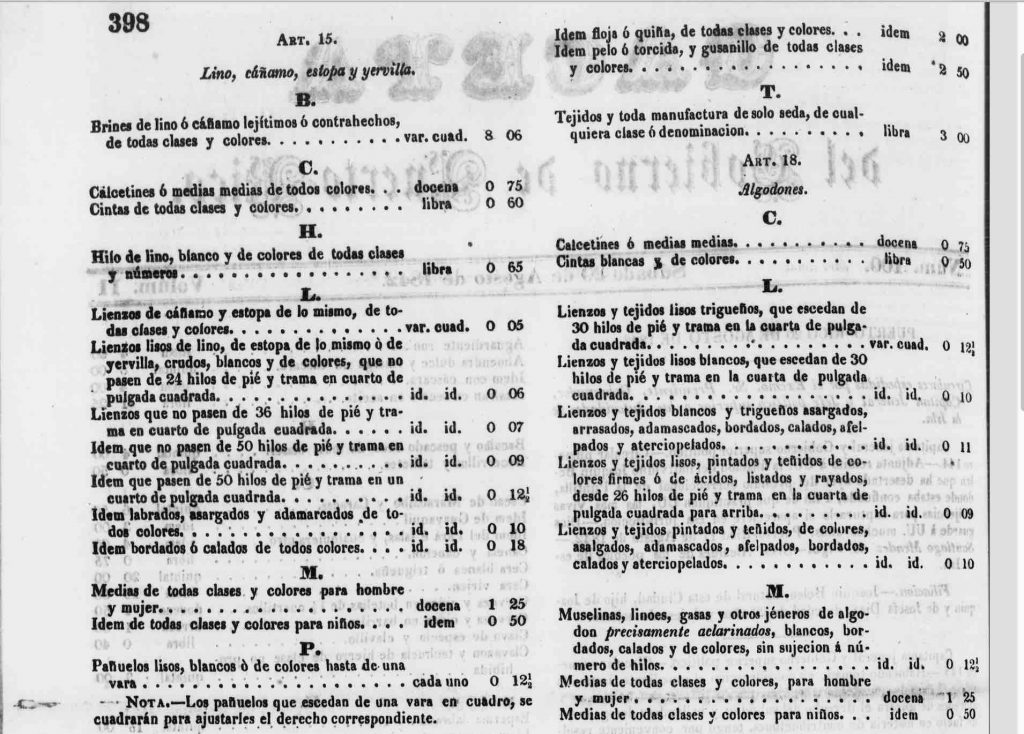
This 1842 list of import taxes on fabric from Mexico published in the Gaceta de Puerto Rico shows different weights of linen ‘Lienzos’ in two columns. Notice there’s a wide variety of painted and woven fabrics and lace that points to the growth of consumption, new markets for self fashioning. It’s not clear where the fabric used for Juan de la Rosa’s linen coletas were sourced from Mexico, or somewhere in Europe. Given the trade networks in the Caribbean, many kinds of arrangements were possible, with goods arriving in ports on the west side of the island too.
As the century wore on, precut or ready made garments were part of the trade in cloth; in the 1840s, industrial production was beginning but not on the island. The work of transforming fabric into clothing by hand sewing was a means of employment for women in the garment industry. Feminist historian Maria del Carmen Baerga Santini gives an idea of this development in Europe:
“Historically women were concentrated in industries with low grades of mechanization; while the sale of production was smaller, larger was the concentration of female labor… From the start of the industrial system one of the principal sources of female manufacturing labor was work related to dress. At the start of the nineteenth century the expansion of demand for ready made clothes translated into the incorporation of thousands of women in the industrial system of France and England.” [26]
And yet, whether the cloth was brought by the yard or pre cut, in Puerto Rico there was a need for manufacture given that the only industry that had limited technical development was sugar cane processing, sewing would still be accomplished by hand by groups of women. Enslaved ancestors also gained these skills which contributed to their survival and support after freedom. Sewing and lacemaking were skills transmitted from person to person on estancias and haciendas, and elite women learned needlework as part of their education. [27]. What remains to be learned are specifics on the scale of production for clothing the enslaved in the late eighteenth to early nineteenth century Puerto Rico.
For those who stole themselves, clothing meant opportunity, a chance to regain control over the conditions of their lives, and ultimately keep moving to freedom. What Juan de la Rosa wore that December 1842, the landscapes he remembered, and the unknown outcome of his flight still matter.
Conclusion
Was stealing oneself an effective strategy? Benjamin Nistal Moret notes that of over 700 cases that he studied, there were an additional 800 cases of libertos who ran away between 1873-1876 just as the contracts for free labor to the actual abolition of slavery occurred— and they disappeared without a trace. [28]
The sale of humans as property and the embodiment of the state, church and slaveowner, that interlocking set of conditions that constituted a social structure designed to support slavery is a dimension overlooked by those who want to relegate the institution of slavery to the past. It is much easier for some to instead substitute a nostalgic past devoid of daily violence.
Refuting perspectives that would reconstitute the past as a tropical ‘Gone with the Wind’, serves to obscure enslavement’s very real legacy in the present— so cast a critical eye on those vacation advertisements. The residues and residual structures are very much still with us (13th Amendment; shackles are now electronic, POC disproportionately impacted). That these issues still reach into the present is why working alongside friends, families and institutions willing to unpack such moments can help to connect and shift the narrative on the past and the stories we tell, the world we share.
Raise your ancestors into visibility!
References
I highly recommend Guillermo A. Baralt’s esclavos rebeldes: consipriaciones y sublevaciones de esclavos en Puerto Rico (1795-1873). Ediciones Huracan, 1981; published in English Slave Revolts in Puerto Rico, Marcus Weiner Publishers, 2007; Ivonne Acosta Lespier’s amazing “Mujeres esclavas en Mayaguez, 1872″ http://www.mayaguezsabeamango.com/index.php?option=com_content&view=article&id=763&Itemid=101 brings attention to the attempts at & resistance to dehumanization and the phenomenon of female slave owners. Benjamin Nistal Moret’s Esclavos profugos y cimarrones: Puerto Rico 1770-1870, Editorial UPR (1984) also helped to understand the network of powers that those who undertook ‘diasporic marronage’ sought to evade. Milagros Denis’ long review article is also worth reading & thinking with. These works informed my discussion of the Reglamentos, or slave codes in Puerto Rico.
[1] “Anuncios.” Gazeta de Puerto-Rico. [volume] ([San Juan, P.R.) 1806-19??, December 29, 1842, Page 624, Image 4 Image provided by University of Puerto Rico, Río Piedras Campus, Library System https://chroniclingamerica.loc.gov/lccn/2013201074/1842-12-29/ed-1/seq-4/ #date1=1789&sort=date&date2=1963&words=Andrea+Gonz%C3%A1lez& searchType=basic&sequence=0&index=2&state=Puerto+Rico&rows=20&pr oxtext=andrea+gonzalez&y=11&x=7&dateFilterType=yearRange&page=1
[2] Accounts from Brazil and Columbia testify to the power of hair to relay messages: DeNeen Brown, “Afro-Colombian women braid messages of freedom in hairstyles.” Washington Post, July 8, 2011. “Mapping Out Freedom: Escaped Slaves Used Braids For Direction”. https://hellobeautiful.com/2877570/braids-cornrows-maps-for-slaves/ ; “The Interesting Fact About How Slaves Used Cornrow Hair Braiding To Escape”, 4 Nov 2017
https://www.theblackloop.com/interesting-fact-slaves-used-hair-braiding-escape/
[3] http://astropixels.com/ephemeris/phasescat/phases1801.html]
[4] Jorge L Chinea “Diasporic Marronage: Some Colonial and Intercolonial repercussions of Overland and Waterborne Slave Flight, with Special Reference to the Caribbean Archipelago” Revista Brasileira do Caribe Brasília, Vol. X, no19. Jul-Dec 2009, 259-284; p263; S.v. Maroon resistance and settlement on Danish St. Croix..” Retrieved Apr 06 2018 from https://www.thefreelibrary.com/Maroon+resistance+and+settlement+on+Danish+St.+Croix.-a0280557943
[5] Antonio Nieves Mendez, Historia de un pueblo: Moca 1772 al 2000. lulu.com, 372
[6] Nieves Mendez, Historia de un pueblo: Moca 1772 al 2000. 366
[7] Nieves Mendez Historia de un pueblo: Moca 1772 al 2000. 311
[8] Carlos Encarnacion Navarro, AGPR, Caja 1327 1-30-1810 fol 19-20, 10-19-1811, fol. 54-54v.,10-30-1811 fol 55-55v
[9] David Stark, “Discovering the Invisible Puerto Rican Slave Family: Demographic Evidence from the Eighteenth Century” Journal of Family History, 21:4, Oct 1996, 393-418; 403
[10] Metcalf, quoted in Stark, Discovering the Invisible Puerto Rican Slave Family: Demographic Evidence from the Eighteenth Century”; 403
[11] Reglamento sobre la education, trato y ocupaciones que deben dar a sus escalos los duenos y mayordomos en esta Isla, 12 agosto 1826
[12] Documento No. 179. “Reglamento sobre la education, trato y ocupaciones que deben dar a sus escalos los dunes y mayordomos en esta Isla, 12 agosto 1826” El proceso abolicionista en Puerto Rico: Documentos para su estudio, Vol II: Proceso y efectos de la abolición, 1866-1896, 103-112.1978 , 110
[13] Documento No. 179. “Reglamento sobre la education, trato y ocupaciones que deben dar a sus escalos los dunes y mayordomos en esta Isla, 12 agosto 1826” El proceso abolicionista en Puerto Rico: 106
[14] Milagros Denis, “Review Essay, The Problem of Slavery in the Puerto Rican Society Reseña de “Sugar, Slavery, and Freedom in Nineteenth Century Puerto Rico” de Luis Figueroa, “La esclavitud menor: la esclavitud en los municipios del interior de Puerto Rico en el siglo XIX” de Mariano Negrón Portillo and Raúl Mayo Santana y “Slave Revolts in Puerto Rico” de Guillermo Baralt. Centro Journal, vol. XXI, núm. 1, 2009, pp. 236-245 http://www.redalyc.org/articulo.oa?id=37721248012
[15] Documento No. 179. “Reglamento sobre la education, trato y ocupaciones que deben dar a sus escalos los dunes y mayordomos en esta Isla, 12 agosto 1826” El proceso abolicionista en Puerto Rico: 109
[16] Ileana M. Rodriguez-Silva , “Abolition, Race, and the Politics of Gratitude in Late Nineteenth- Century Puerto Rico” Hispanic American Historical Review 93:4, 621-657
[17] Capitulo III Art. 3, 4. Documento No. 179. “Reglamento sobre la education, trato y ocupaciones que deben dar a sus escalos los dunes y mayordomos en esta Isla, 12 agosto 1826” El proceso abolicionista en Puerto Rico: 105
[18] Antonio Nieves Mendez, Historia de un pueblo: Moca 1772 al 2000. 372.
[19] Nieves Mendez, Historia de un pueblo: Moca 1772 al 2000. 385.
[20] Gazeta de Puerto-Rico. [volume] ([San Juan, P.R.), 20 Aug. 1842. Chronicling America: Historic American Newspapers. Lib. of Congress. <http://chroniclingamerica.loc.gov/lccn/ 2013201074/1842-08-20/ed-1/seq-2/>
[21] Benjamin Nistal Moret, Cimarones y esclavos prófugos
[22] Documento No. 179. “Reglamento sobre la education, trato y ocupaciones que deben dar a sus escalos los dunes y mayordomos en esta Isla, 12 agosto 1826” El proceso abolicionista en Puerto Rico:
[23] Robert S. DuPlessis, « What did Slaves Wear? Textile Regimes in the French Caribbean »,
Monde(s) 2012/1 (N° 1), p. 175-191. https://www.cairn.info/revue-mondes1-2012-1-page-175.htm
[24] Luis Diaz Soler, Historia de la esclavitud en Puerto Rico. 169
[25] Madelyn Shaw, Slave Cloth and Clothing Slaves: Craftsmanship, Commerce, and Industry. Journal of Early Souther Decorative Arts. http://www.mesdajournal.org/2012/slave-cloth-clothing-slaves-craftsmanship-commerce-industry/ Also Linda Baumgartner, Clothes for the People–Slave Clothing in Early Virginia. Journal of Early Southern Decorative Arts (NoCar N 6520 .J67), Vol. 14 Issue 2, Nov 1988, p27-70 ; Eulanda A. Sanders, The Politics of Textiles Used in African American Slave Clothing Published in Textiles and Politics: Textile Society of America 13th Biennial Symposium Proceedings, Washington, DC, September 18- September 22, 2012. https://digitalcommons.unl.edu/cgi/viewcontent.cgi?article=1739&context=tsaconf
[26] Maria del Carmen Baerga Santini, Introduccion, Genero y trabajo: la industria de la aguja en Puerto Rico y el Caribe hispánico. Editorial de la Universidad de Puerto Rico, 1993, 6
[27] Ellen Fernandez- Sacco, Mundillo, identity & tourism: The revival and transformation of handmade lace in Puerto Rico.” Maureen Daly Goggin & Beth Fowkes Tobin, eds. Women and Threads: Gender and the Material Culture of Textiles., Ashgate, 2009, 148-166. https://www.academia.edu/154024/Mundillo_and_Identity_the_revival_and_transformation_of_handmade_lace_in_Puerto_Rico

